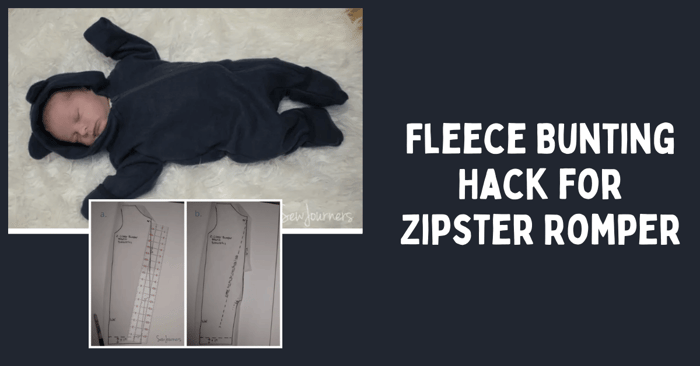
7 Ways to Make an Ear Guard for Face Mask Ear Relief
Hello again! It's Stephanie from Stephie B's Designs here with you again to give you some face mask ear relief. It's only a been a few days since my last post, but we felt this was a relevant and important one that needed to be published as soon as possible.
Face Mask Ear Relief | How to Make a Face Mask Ear Guard
Cloth face masks have become a part of all our lives right now. You may be wearing one to work for hours on end or for only a few minutes during an "essential goods" run. No matter the case, several issues have come to light concerning face masks that I would like to help with today.
- Elastic loops are tearing up the wearer's ears so the point where they bleed. This is often referred to as "ear fatigue."
- Masks are often too big for the wearer it has a hard time staying in place.
- Masks cause the wearer to touch their hair/face more than they should to keep adjusting the ties.
No good on all accounts! Masks should help alleviate stress, not cause more of it. But, the sewing community, health care professionals, and everyday heroes have come up with a few solutions to help solve these problems with things many of you already have laying around your home! Woohoo!
Today's post will show you seven, yes SEVEN!, of those solutions that can be used with face masks made with either elastic bands or those made with ties.
Five of these seven can be made with NO SEWING or sewing skills at all, and the other two only require you to sew on a button. Easy day!
Different Types of Face Mask Ear Protection
Here's what I'll be discussing below:
- Headbands
- A tied headband (no sewing)
- A button headband
- Behind the Head Ear Guards
- A button tab
- A snap tab (no sewing)
- Other Options for Behind the Head Ear Guards
- Ribbon (no sewing)
- Paperclip (no sewing)
- Safety Pin (no sewing)
Option 1 for Face Mask Ear Relief: Headbands
A Tied Headband for Face Mask Ear Relief
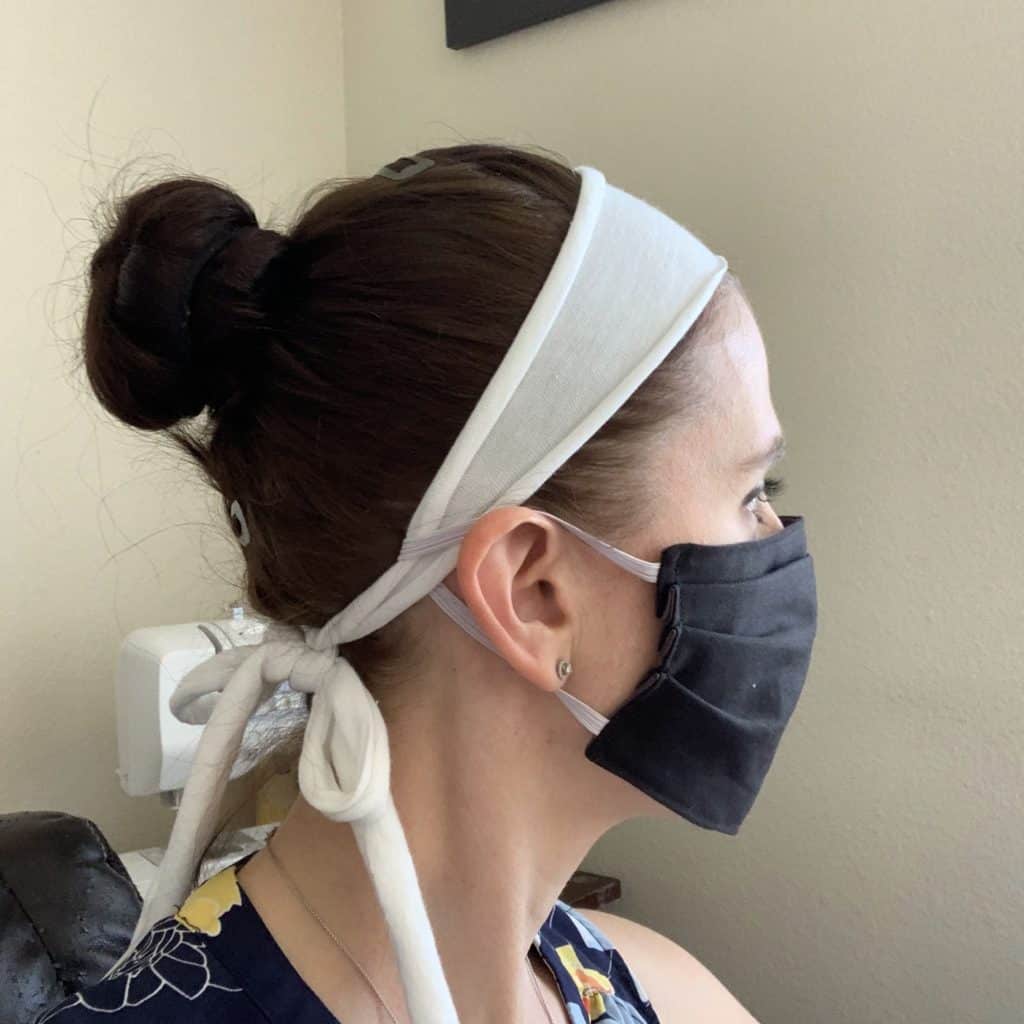
This is quick, easy, and is the method I will be using when I'm shopping for my essentials.
Materials Needed
- Fabric (old shirts, sheets, pillowcases, bandannas, or other fabric you have on hand; woven or knit, it doesn't matter)
- You'll need a strip at least 30" long so keep that in mind when selecting your fabric
- I HIGHLY recommend KnitFabric.com for any type of fabric you want (including quilting cotton for masks).
- Scissors OR rotary cutter and self healing mat
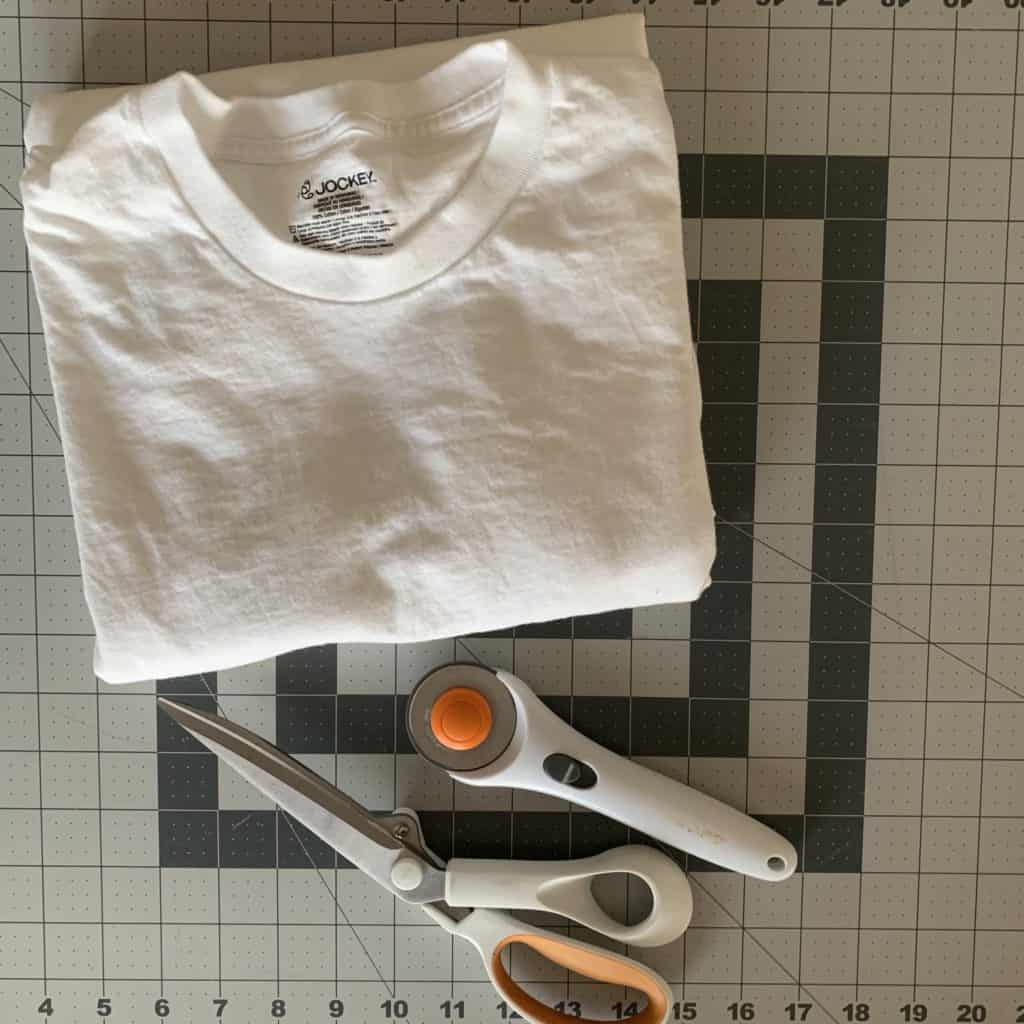
The Steps
Lay out your fabric on a flat surface. If using a t-shirt as I'm doing, cut off the bottom hem.
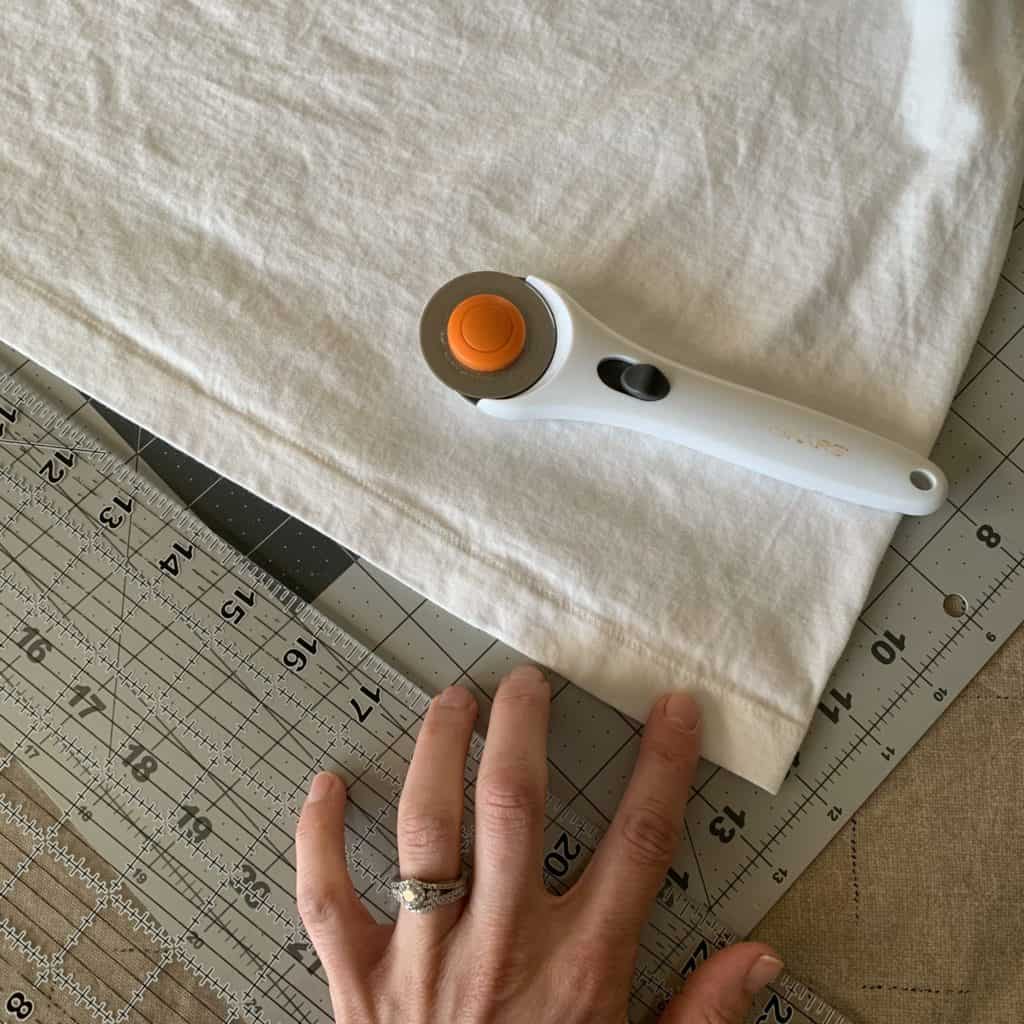
Cut a strip of fabric. I recommend at least 3-4" wide (or the width of four finger) and about 30-36" long. If it's too long, you can cut off excess later.
If using a fabric with will fray, I recommend either finishing the raw edges or doubling the width so you can fold so the raw edges are against your head .
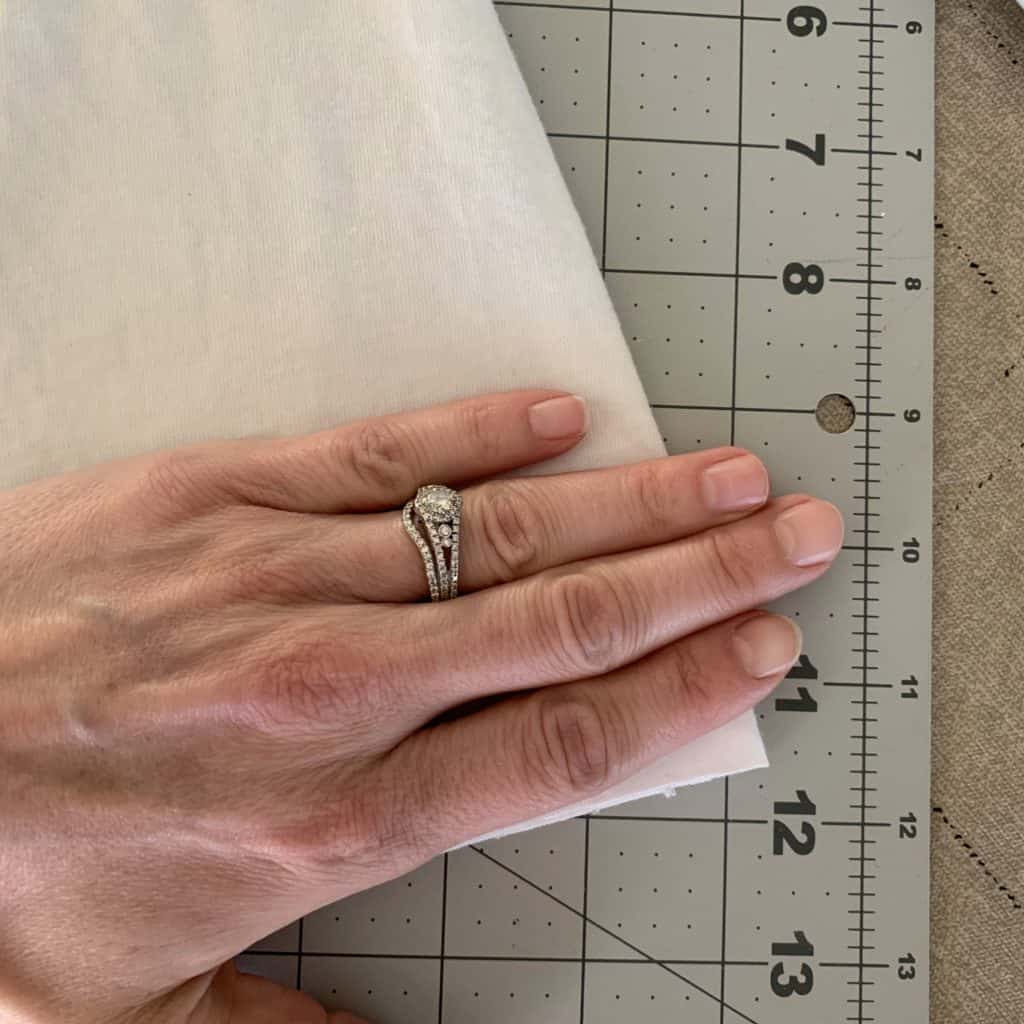
If using a t-shirt or pillowcase, cut one side to open the loop.
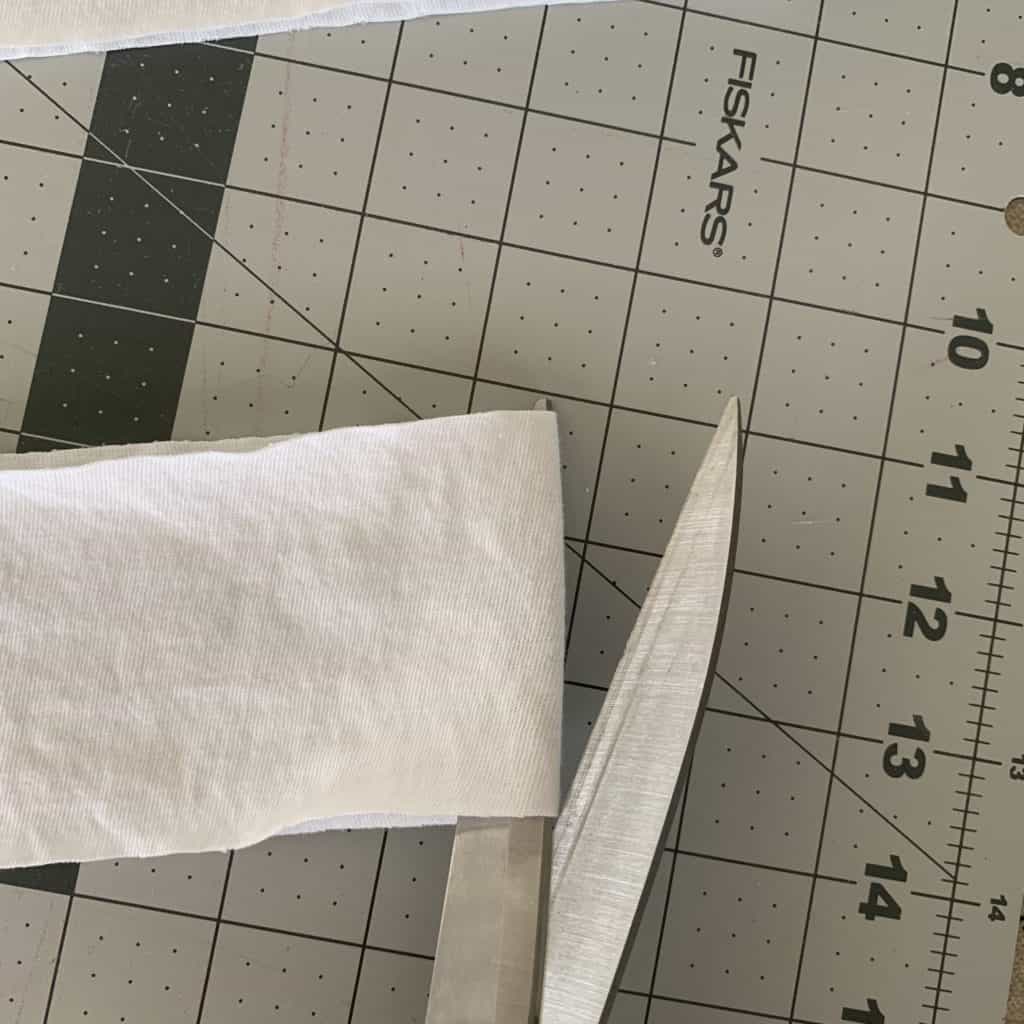
Place the headband on the top of your head. (Please excuse the goofy expressions on my face in some of the photos below!)
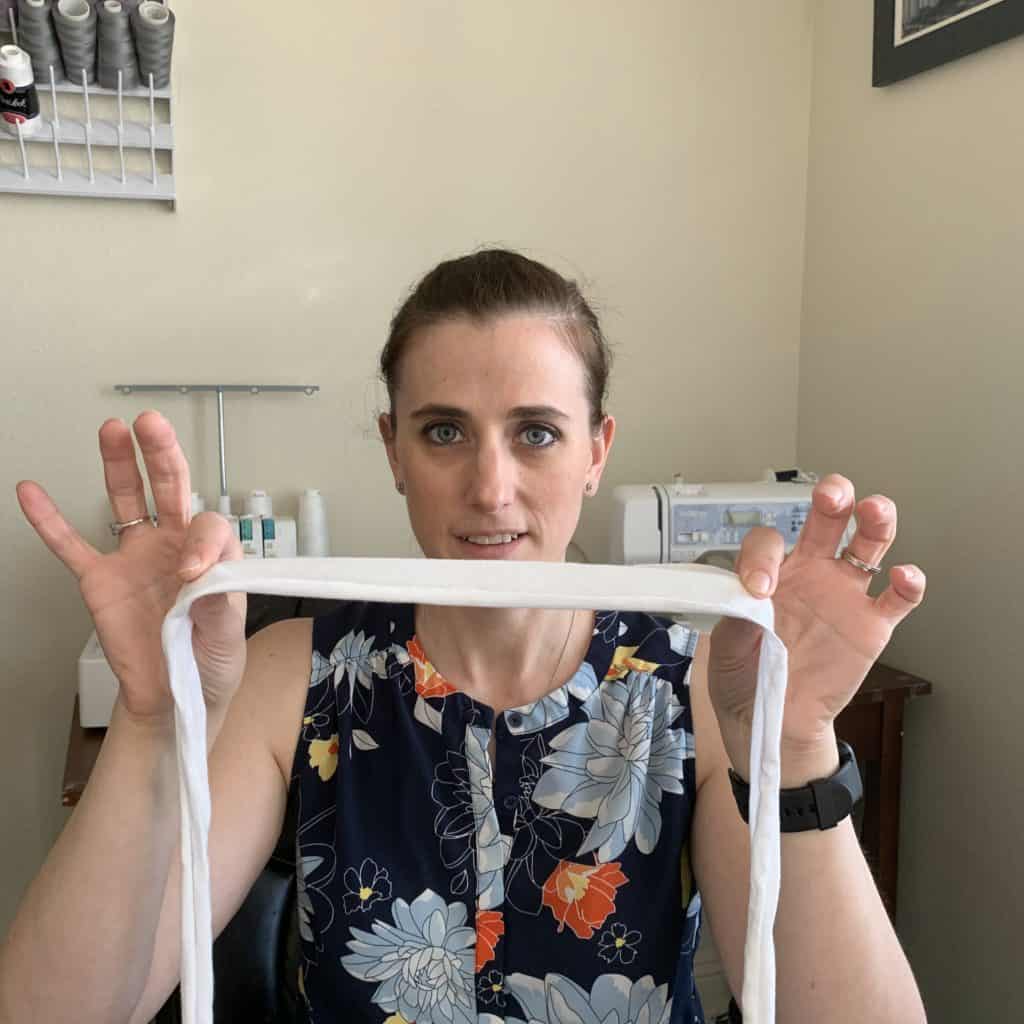
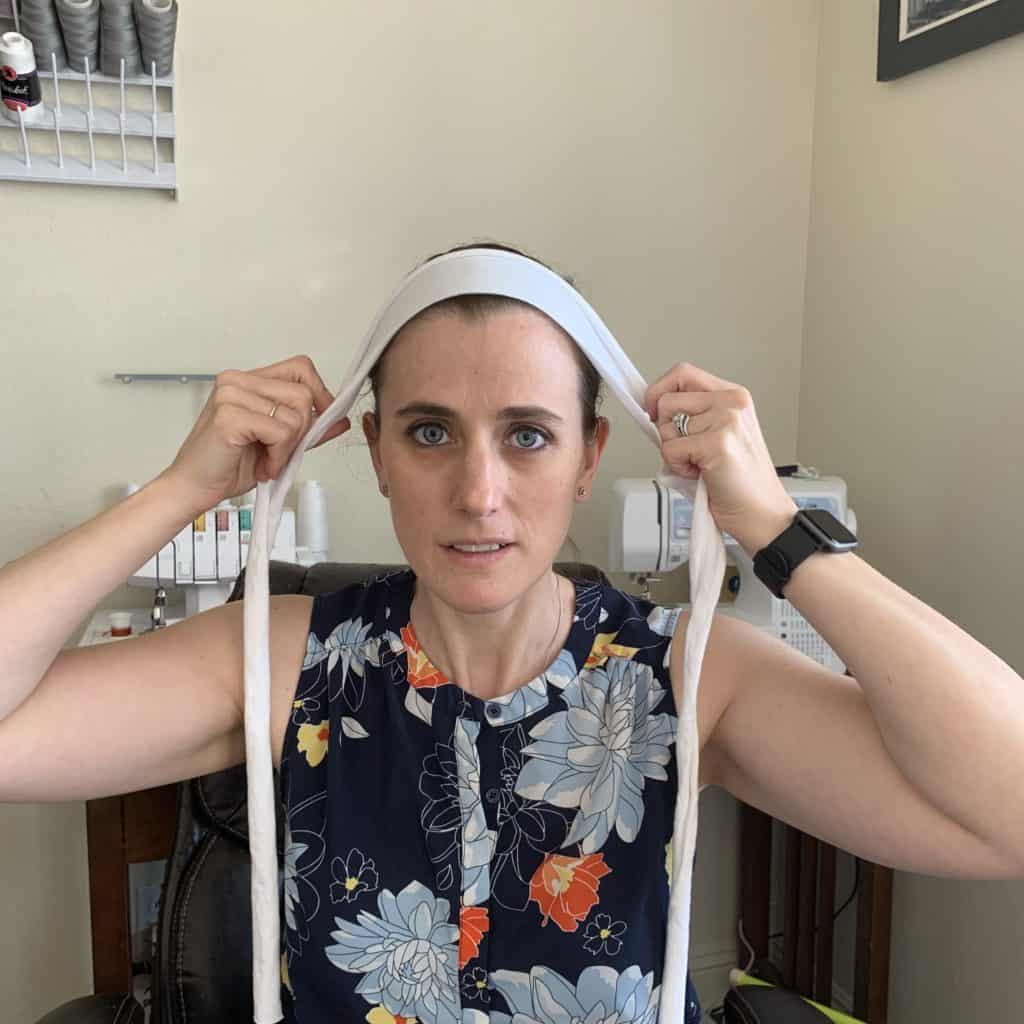
Grab your mask. Feed the ends of the headband through the elastic bands (or tied ties) and position the mask up to your face. You'll be adjusting the exact location later, this is just a rough estimate.
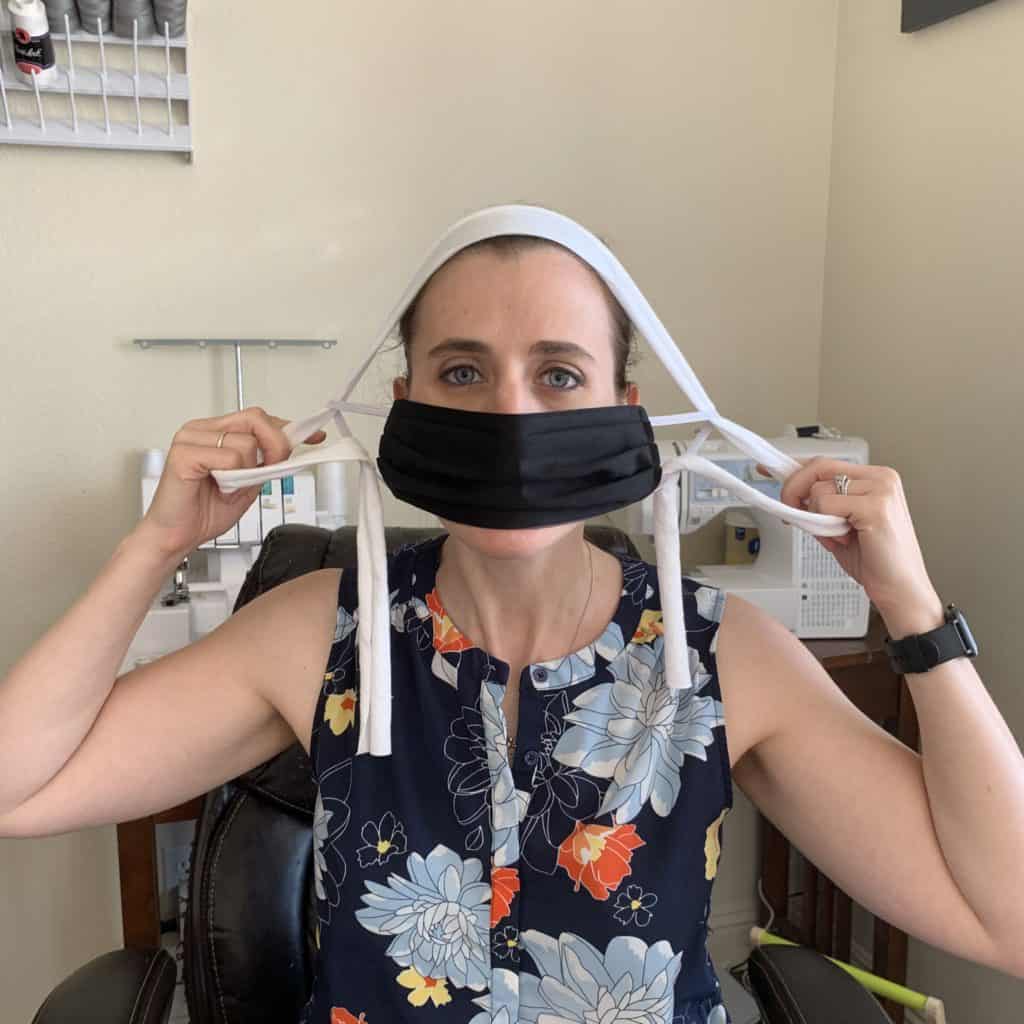
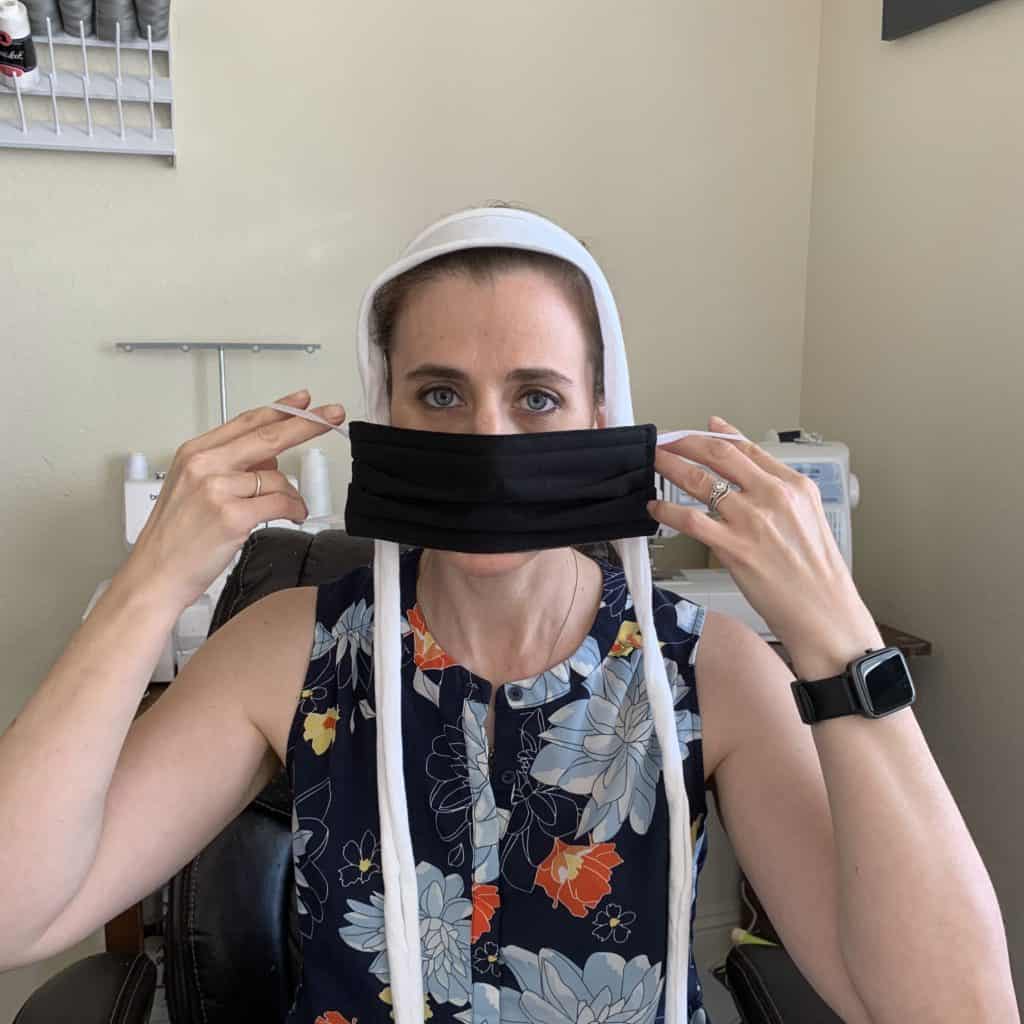
Tie the ends of the headband behind your head/under your hair.
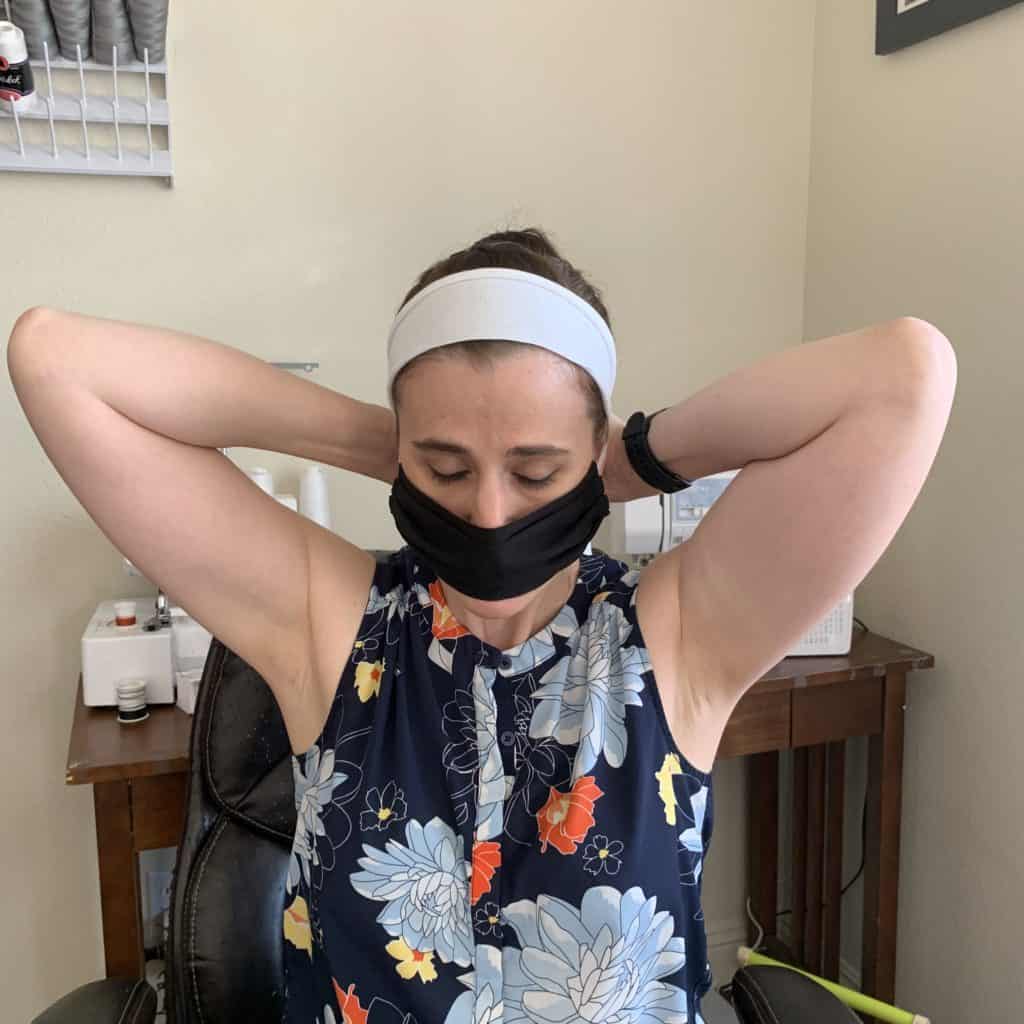
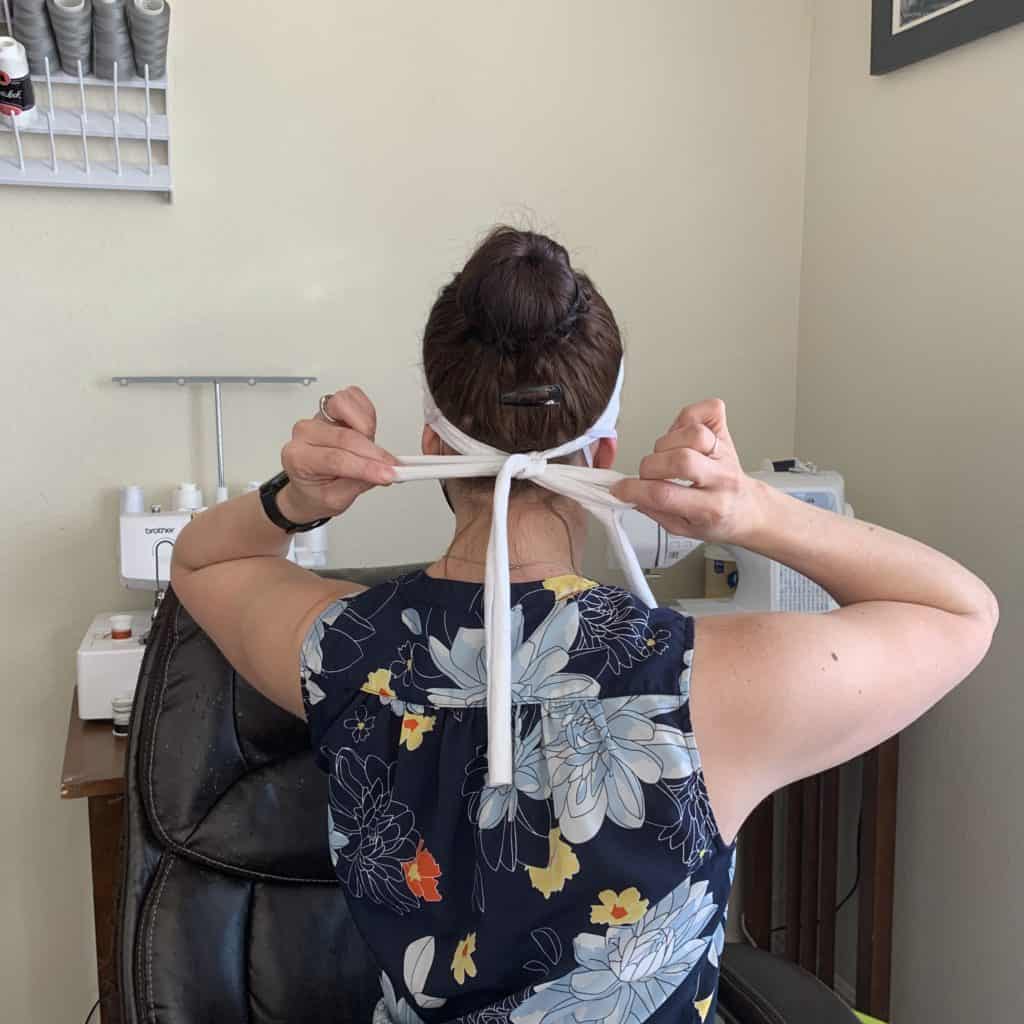
Adjust the elastic/ties and the mask so it sits correctly and comfortably on your face.
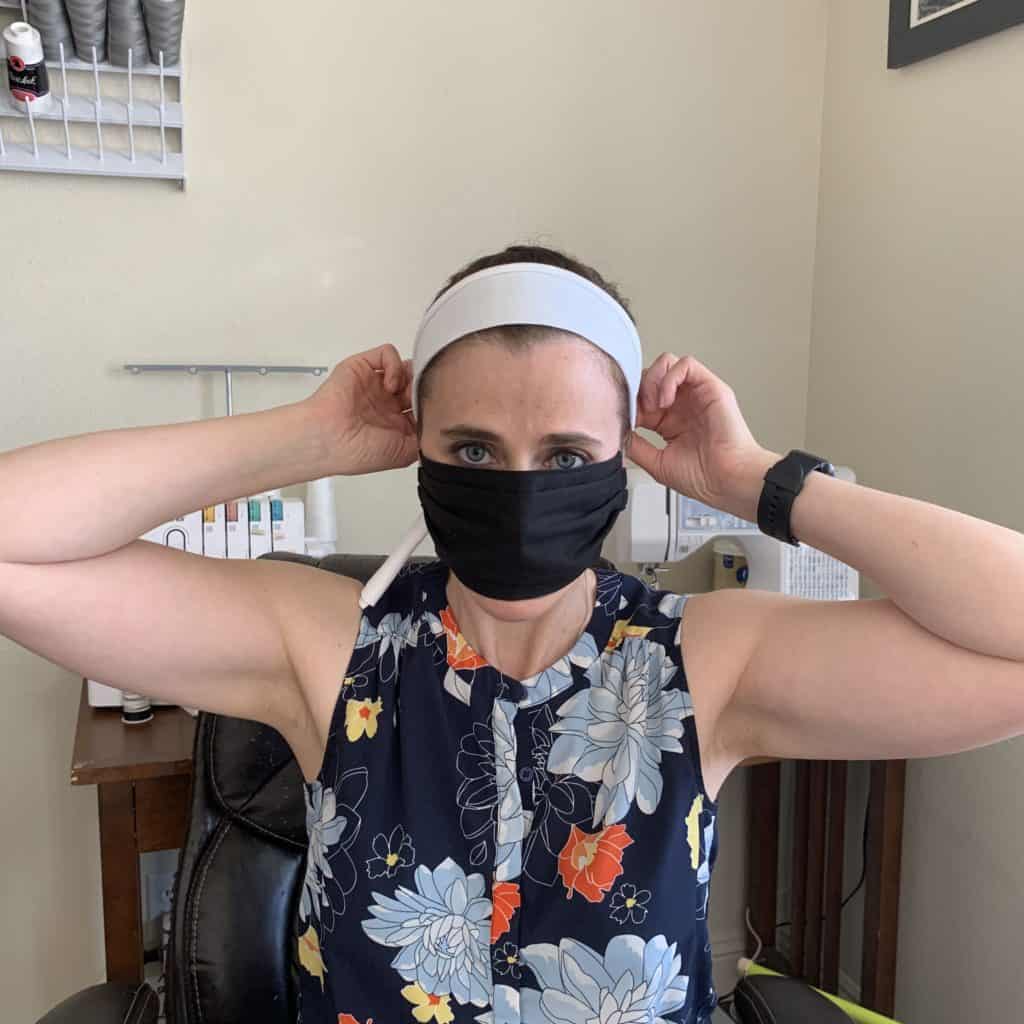
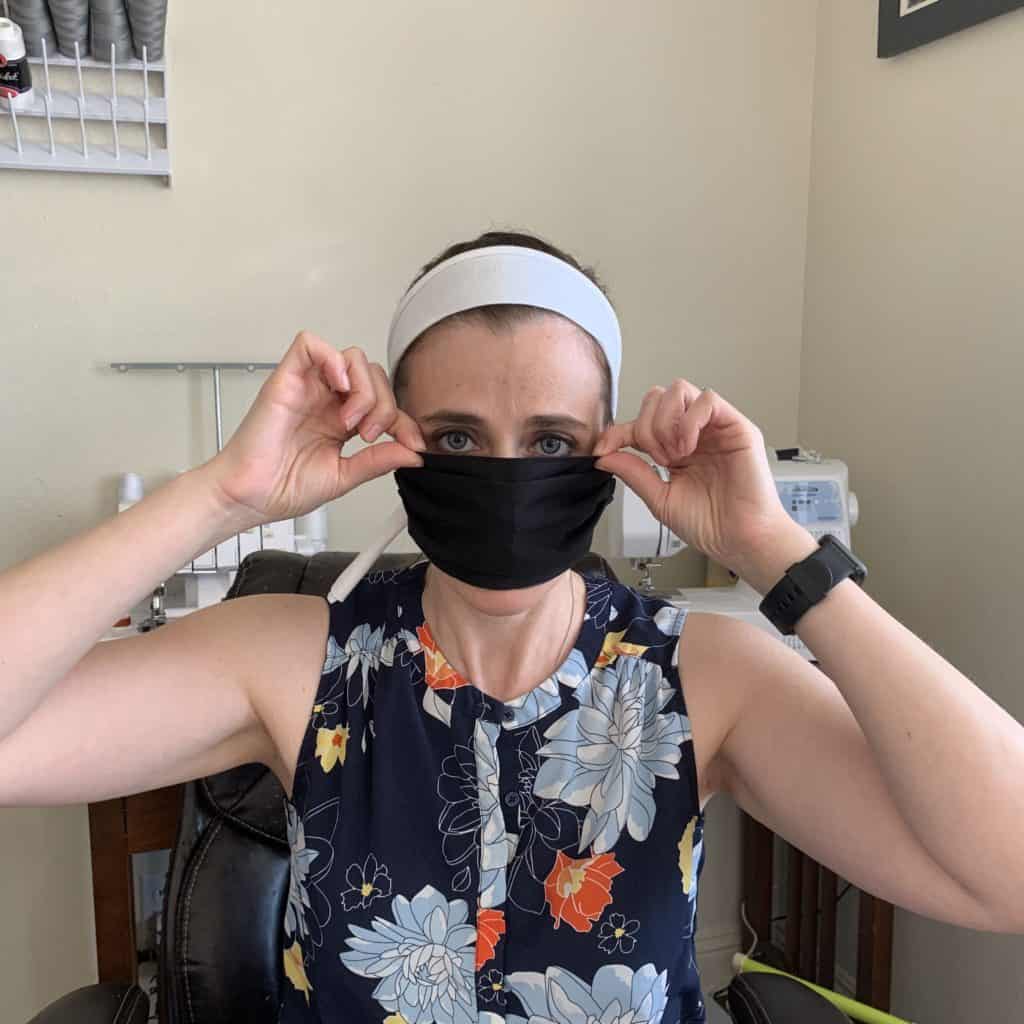
Cut off the excess headband tails if desired.
That's it!!!!
A Button Headband
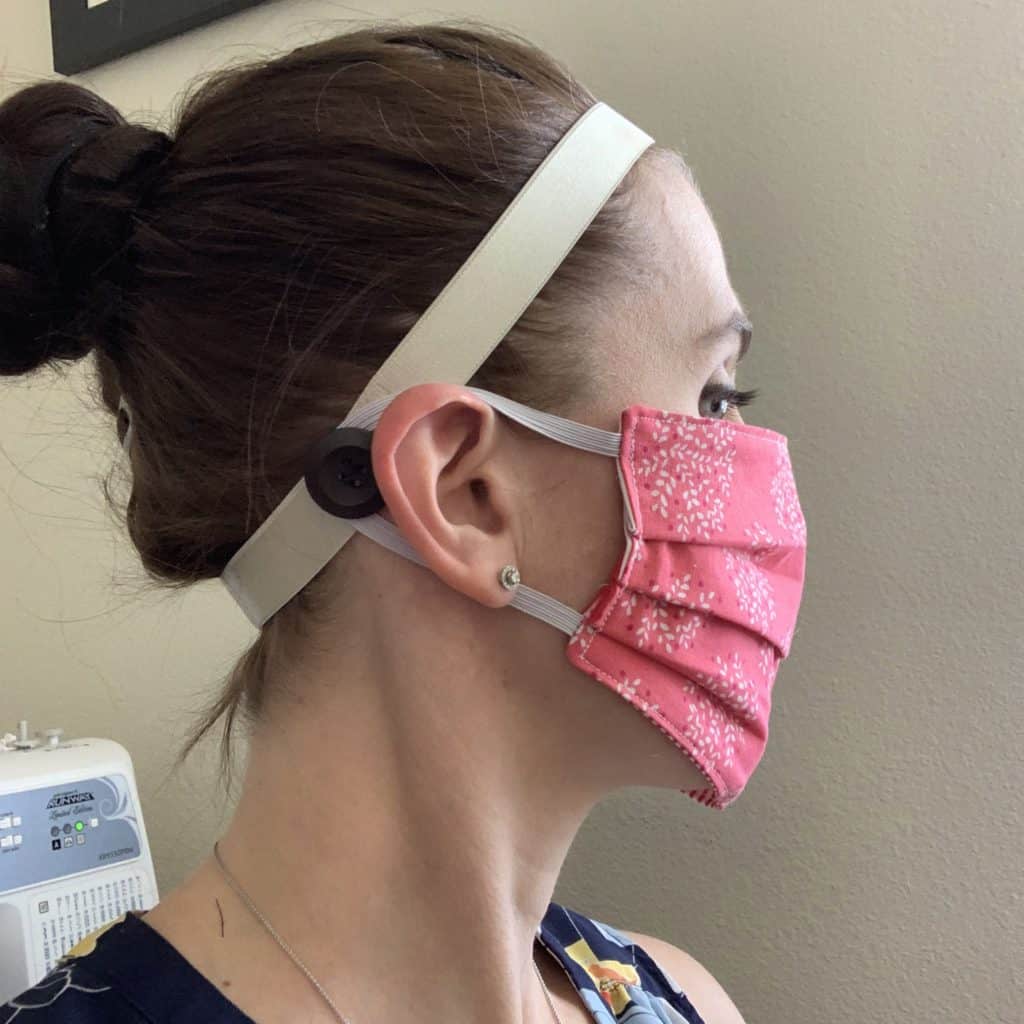
A button headband has two sewn-in buttons by each ear where your mask loops/ties around the buttons. This prevents the elastic from rubbing your ears raw and holds the mask in place.
There are a million headband patterns out there; this method will work with pretty much any of them, including headbands you may already have at home (like the one I used for this tutorial).
A few we've written here on Peek-a-Boo Pages that are worth looking through are Twist Top Headband, Woven (braided) Headband, Flower Head Wrap, Big Bow Headband, and Five Spring Headbands. So many options!
Two I recommend for this project are the Tied Headband that we just talked about, the Woven Tie Headband (made about an inch thicker than the pattern calls for; this can be tied at the top or under your hair) and the Athletic Headband (a thick, stretchy headband, perfect for moving and working all day).
Both the Athletic Headband (check out these athletic knits) and Woven Tie Headband can be hand sewn, and since they each use different fabric types, you should be able to make them from old shirts, sheets, pillowcases, bandannas, or other fabric you have on hand.
Side note... I mentioned this above, but I have to talk about them again. If you're looking for some A.MA.ZING fabric for your headbands or masks or anything, start with KnitFabric.com (formerly Peek-a-Boo Fabric Shop). They've been my go-to for several years so, and I order from them several times a month.
Ok... back to it!
I recommend making a headband that is either thick or wide so it can hold the weight of the elastic pulling on it. My headband is only about 3/4" wide, but it's thick/dense, so works perfectly.
Materials Needed
- Headband
- Two buttons, the bigger the better
- Pen or something to mark your headband
- Sewing machine with button foot OR a thread and needle
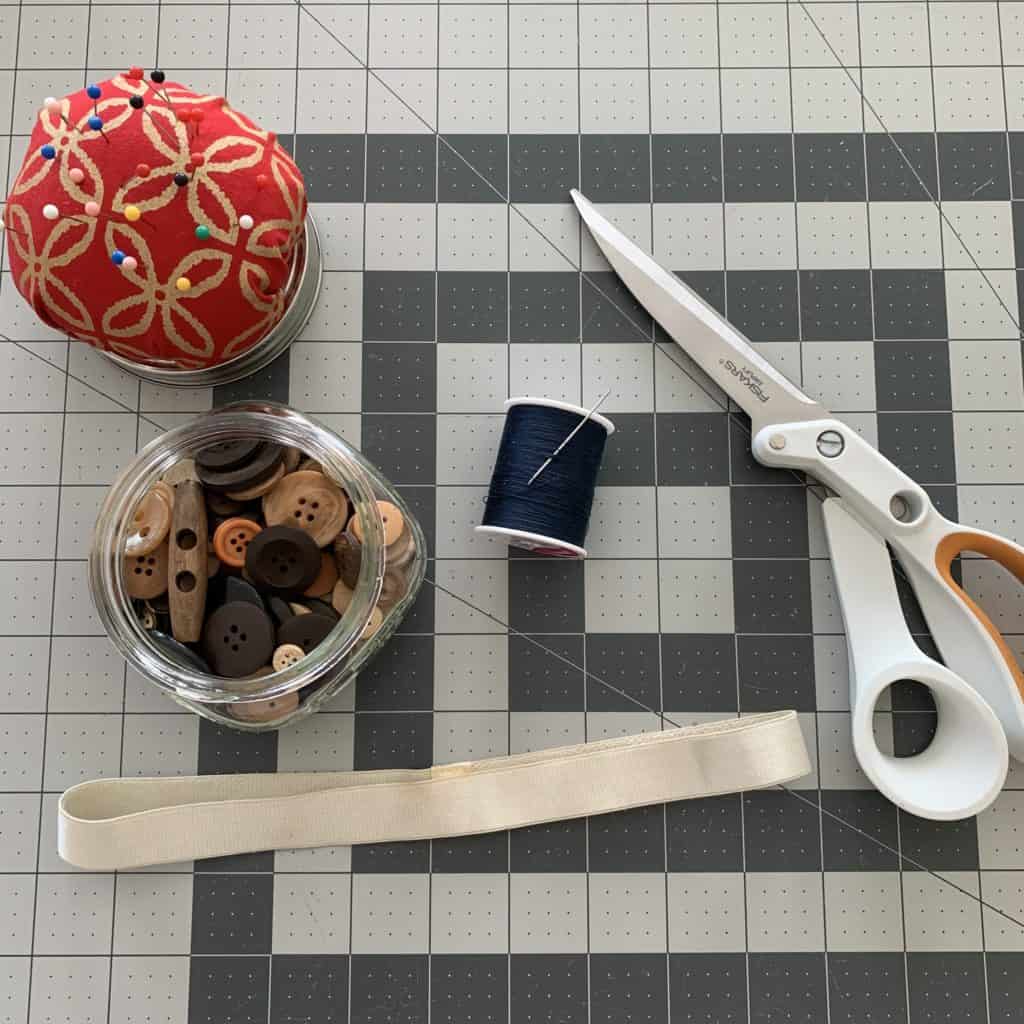
Wait... did you notice my awesome little Mason Jar pin cushion?! Check out the blog and come back. I'll wait. :)
The Steps
Measure 3-4 inches from the center back/bottom and mark. Repeat with the other side.
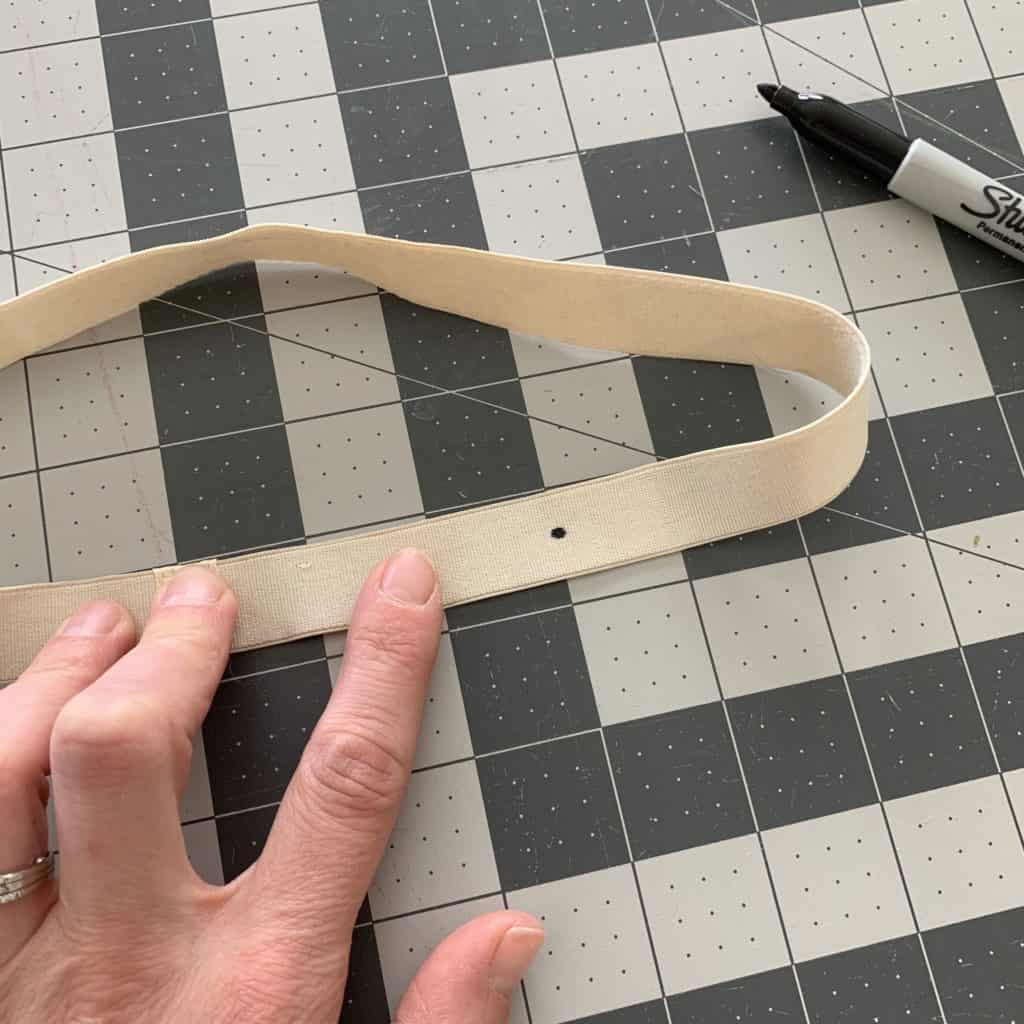
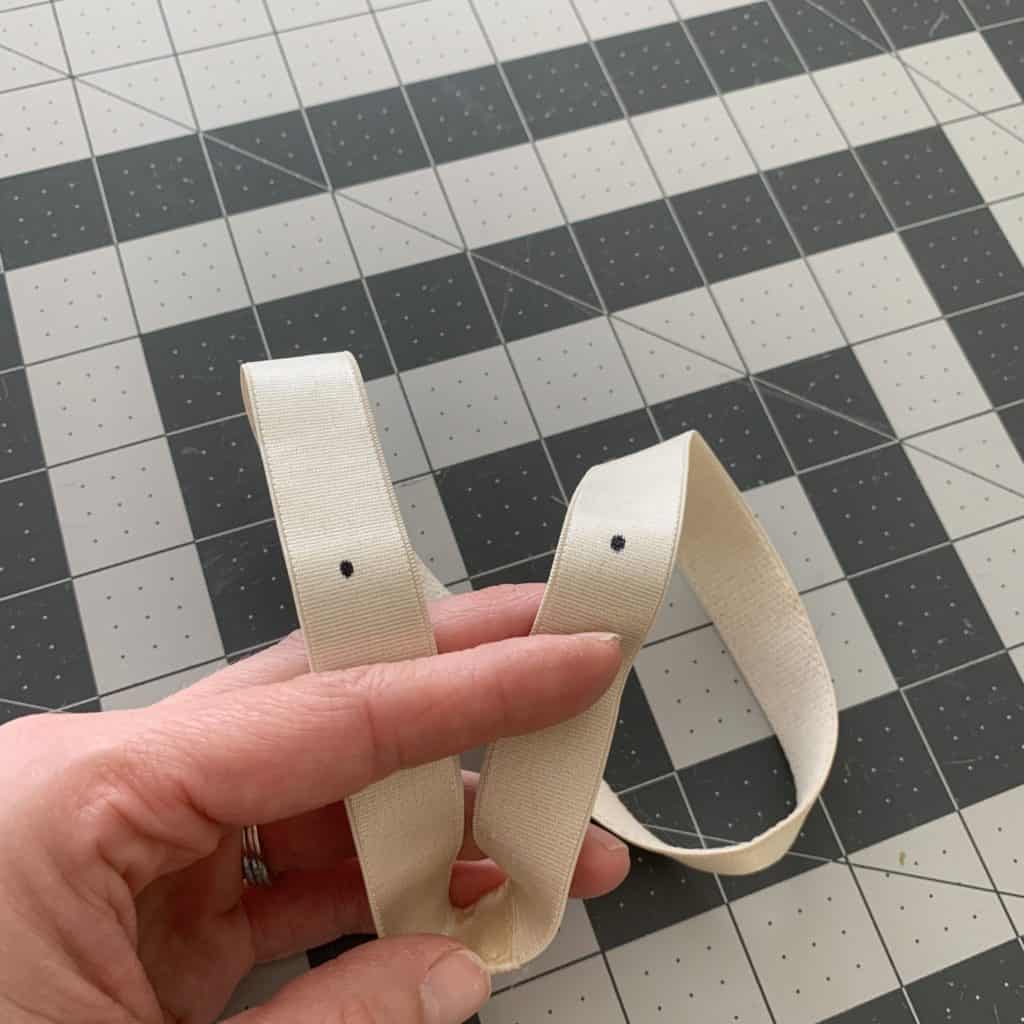
I could have raised the buttons on my headband about an inch and it would have felt better, but each headband will sit on your head differently and require different button placement.
Hand sew or use your sewing machine to add the button.
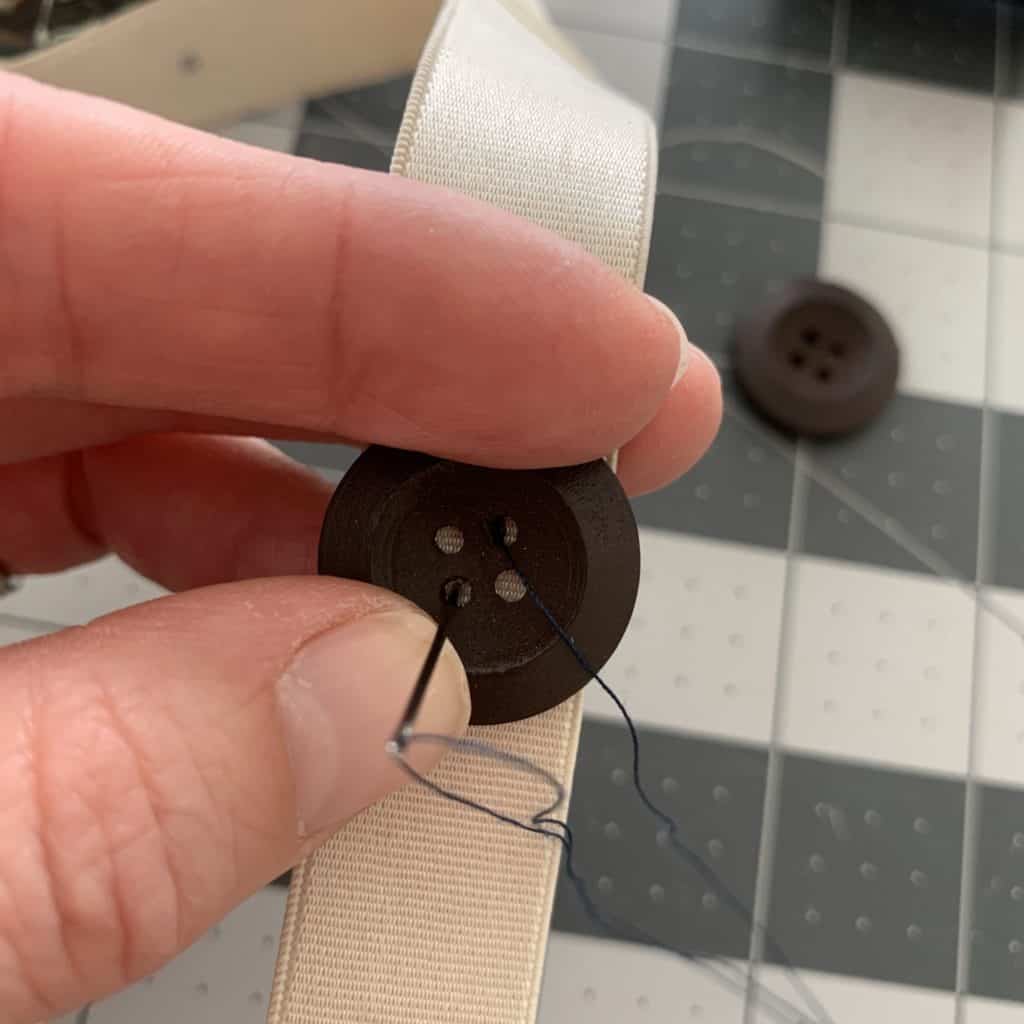
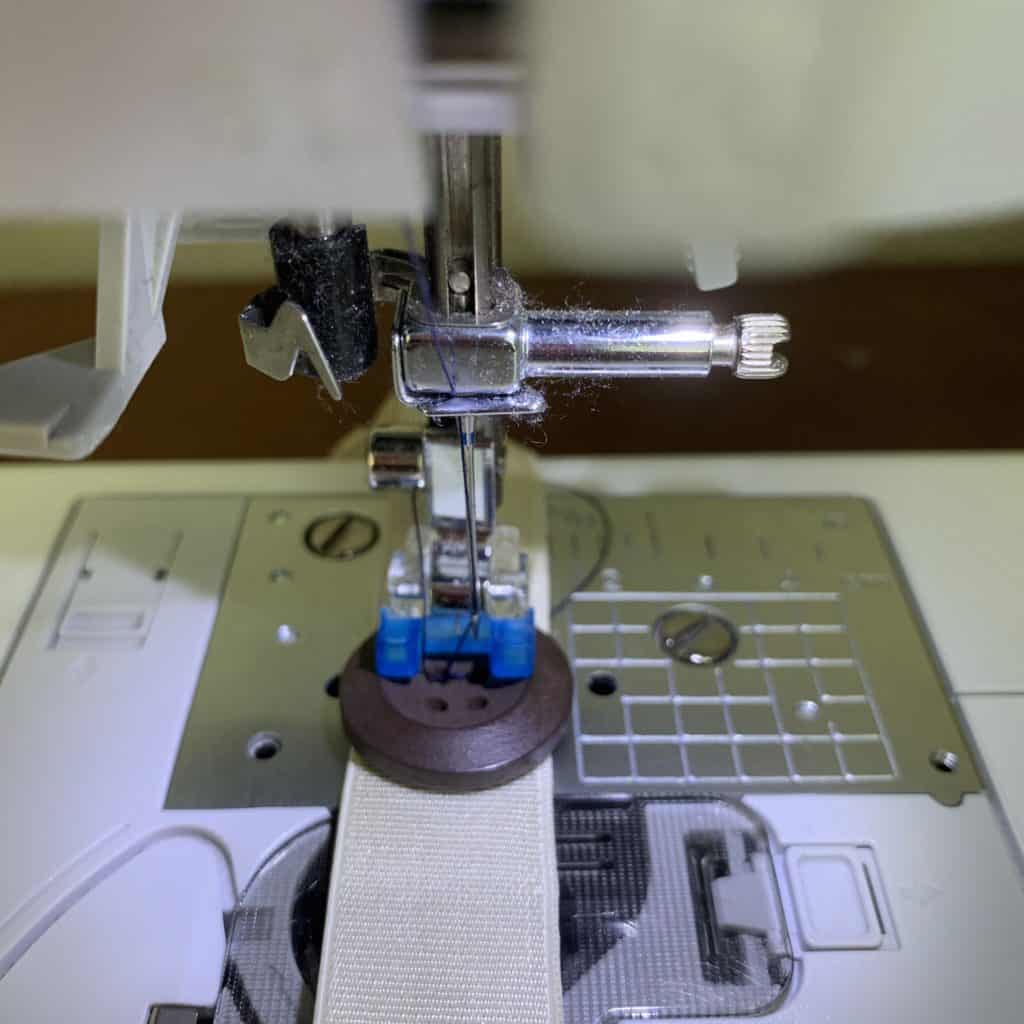
I recommend putting the headband on and checking the button placement before sewing your second button.
That's it!
Behind the Head Ear Guards
The following ear guards are meant to keep the pressure from elastic bands off your ears by holding the bands in place behind your head.
However, these may not work for everyone. They worked well for me, but my husband said very quickly after trying one that they actually pulled down on his ears and felt more uncomfortable than wearing the bands by themselves. I may end up making him a longer one.
The good things is that these only take a few minutes each to make, so if you want to try one just to see, you won't be wasting much time if they end up not working for you.
Button Tab Ear Guard
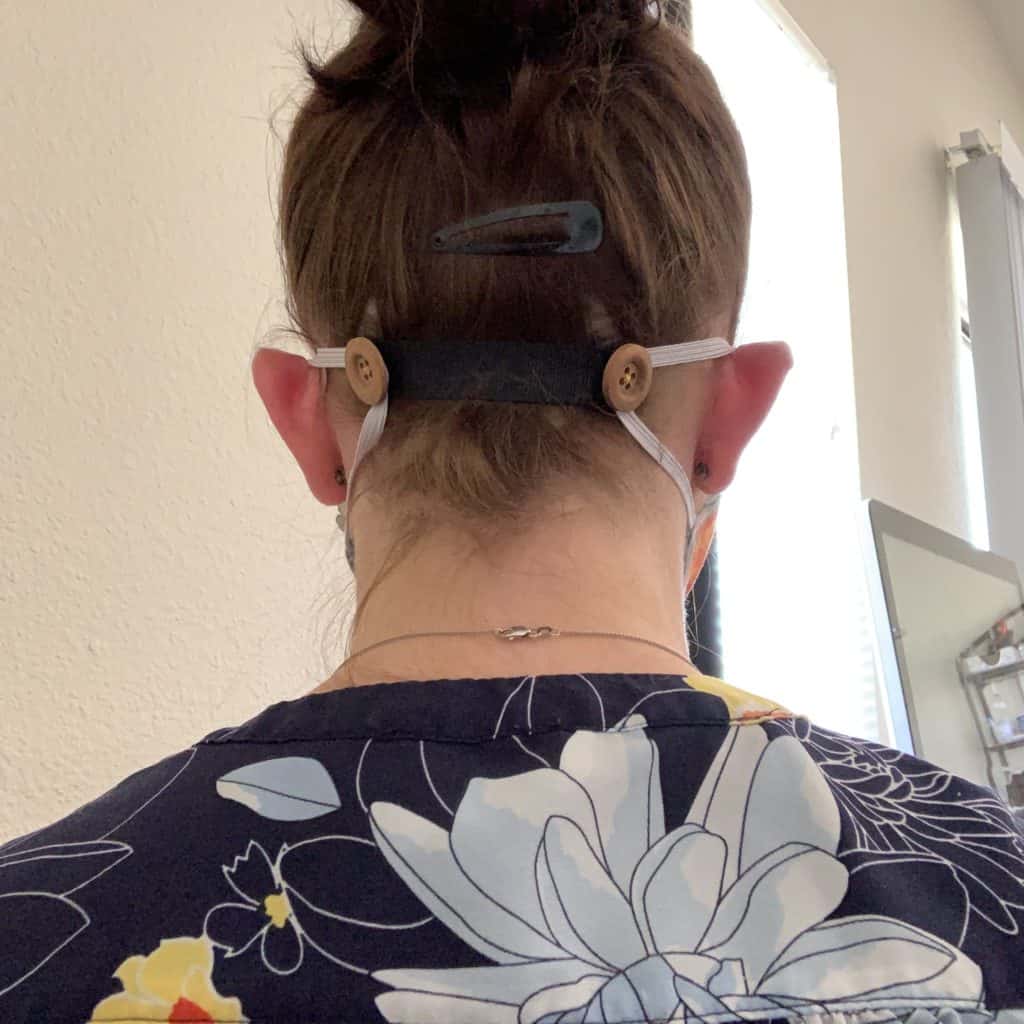
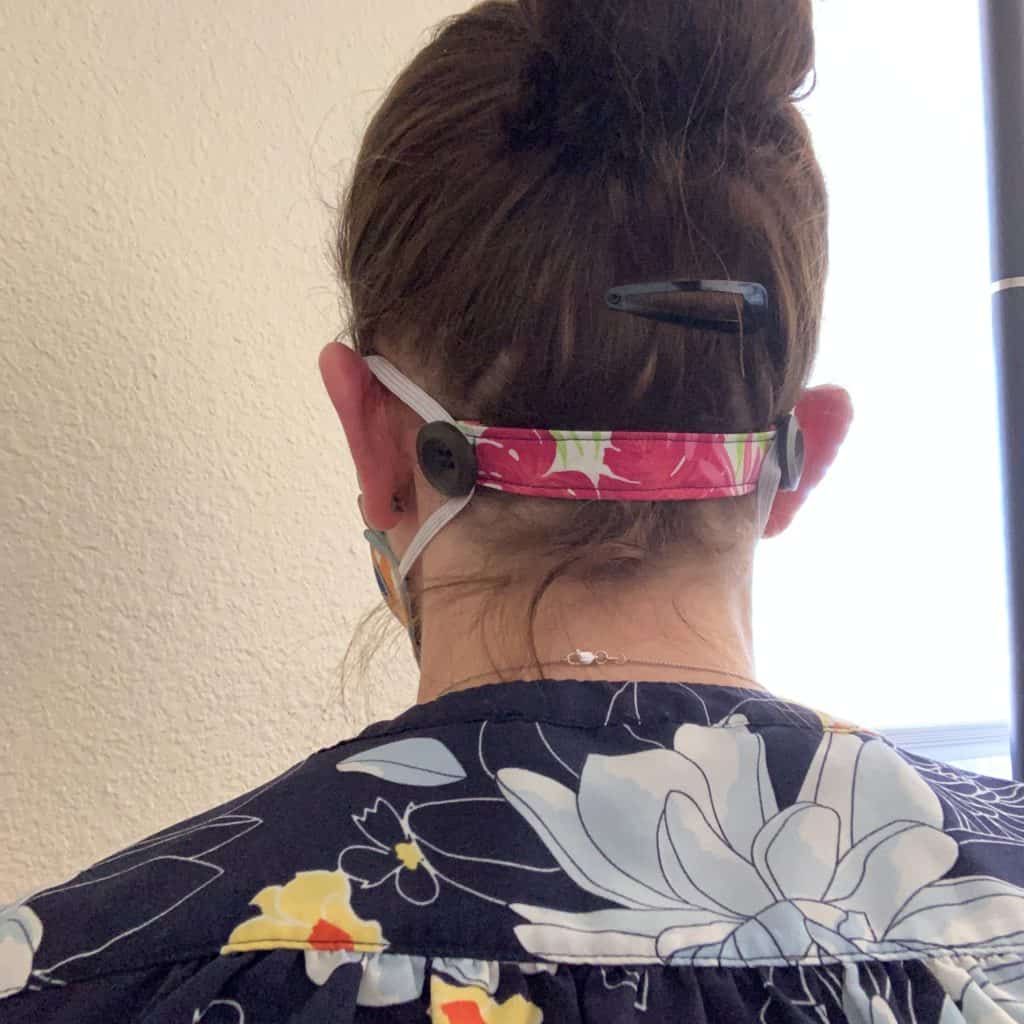
I made two versions, one that you don't need to sew - aside from the button - and one that you can finish with a sewing machine.
If you have fabric that frays (woven cotton; from a sheet or pillowcase for example) you'll need to fold all the edges under. I'll be going over how to do that in the second version, with the colorful pink tab.
Materials Needed
- Fabric/Material
- Grosgrain ribbon, fabric scraps, leather, a crocheted strip, or anything you can find that you think would work
- You need a strip 6-8 inches long by about 1 inch wide.
- (It's worth repeating!) I recommend KnitFabric.com for fabric.
- Two buttons, the bigger the better
- Sewing machine with button foot OR a thread and needle
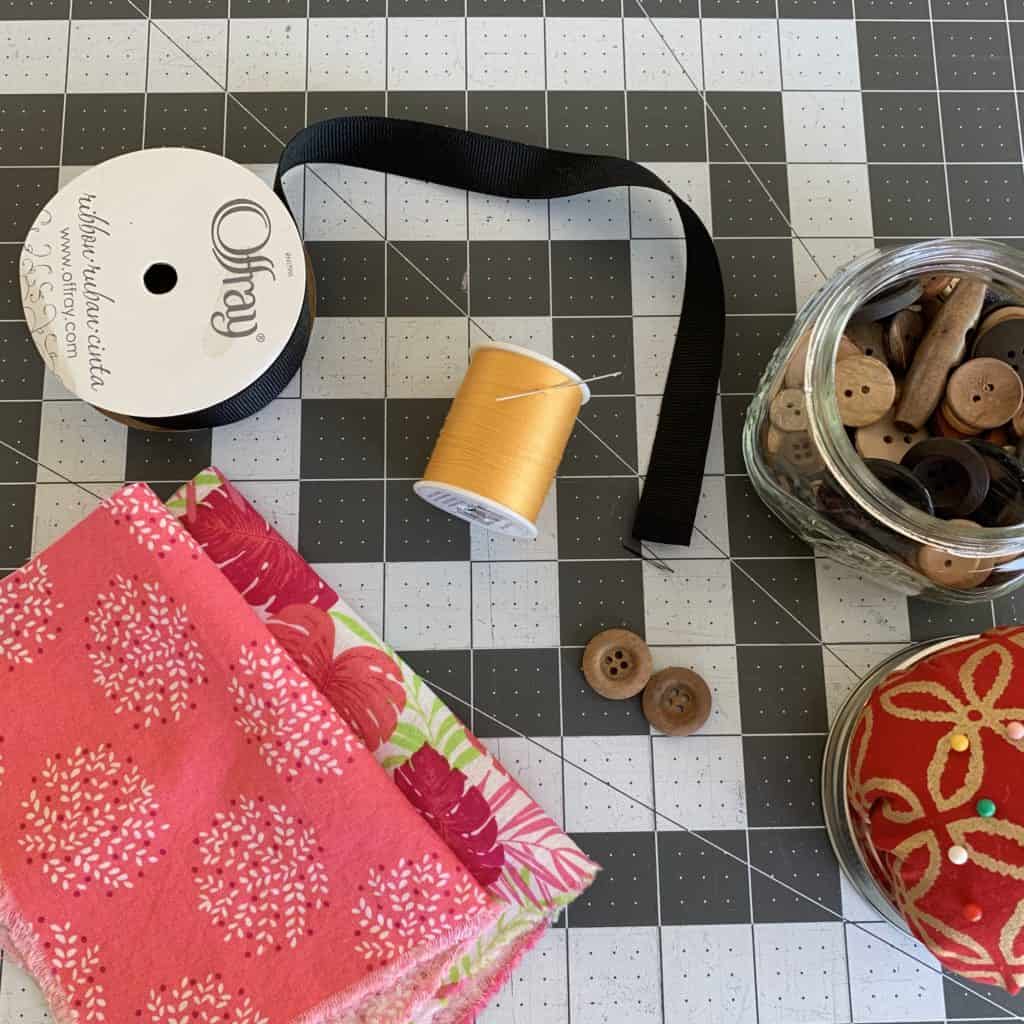
It may be helpful to have someone assist you in measuring how much you need by holding the mask up to your face, pulling the elastic loops securely but comfortably behind your head, and measuring the distance between the loops. You'll add about 2 inches if you need to fold it under (ribbon, woven cotton/sheets/pillowcases).
If using fabric/material that won't fray, all you need to do is sew the buttons on the ends. Done! But if your fabric/material is thin, I recommend following the steps for the version below to reinforce the ends where the buttons will be.
The Steps
Version 1 -
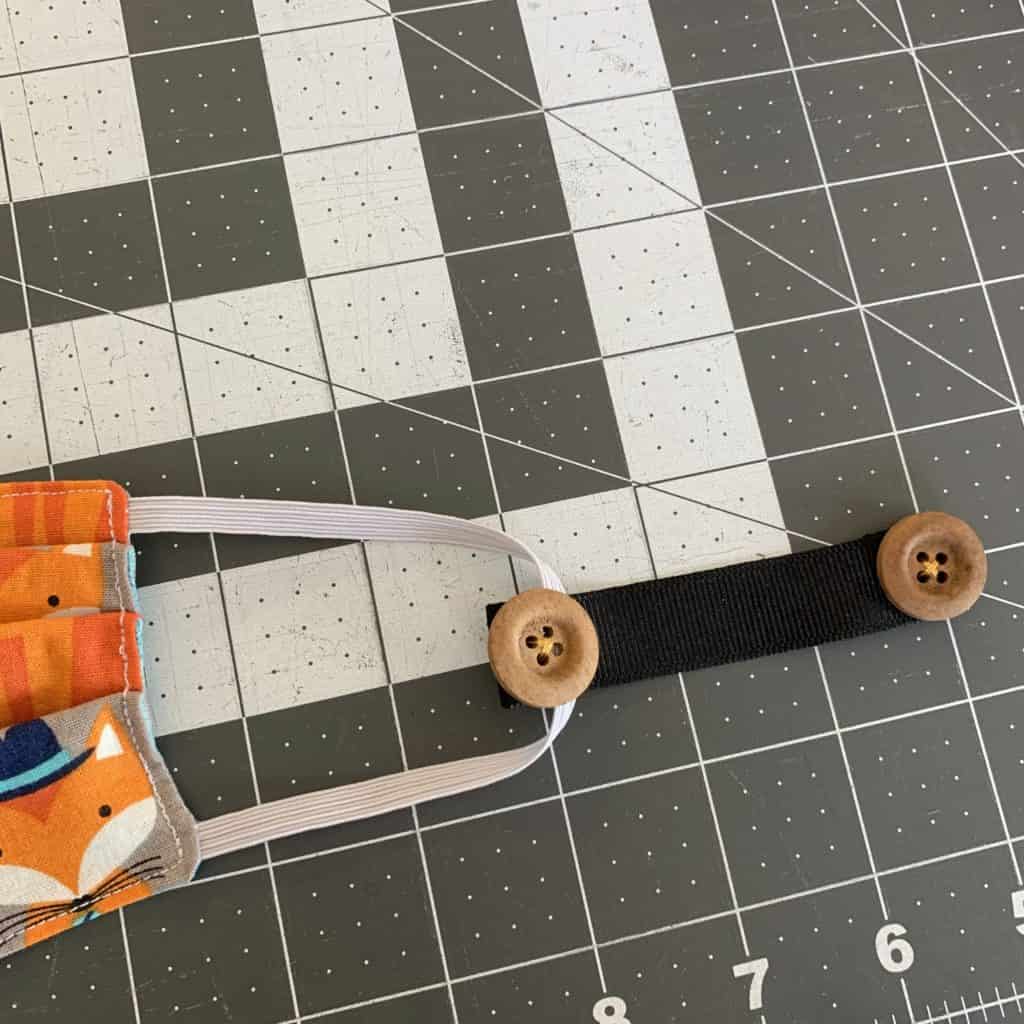
If you're using ribbon, fold the ends under 1/2 inch two times to prevent fraying and add stability.
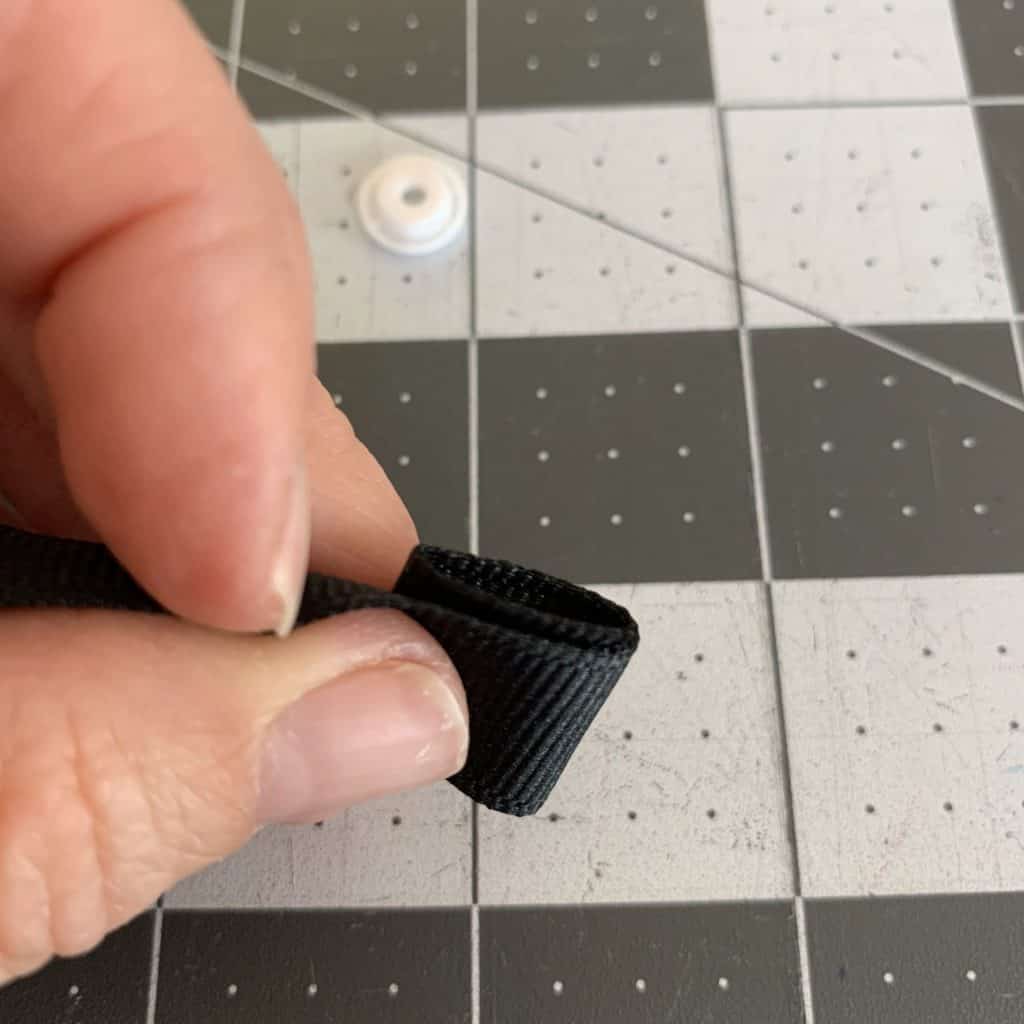
Add a button to each side, sewing in place by hand or with a sewing machine.
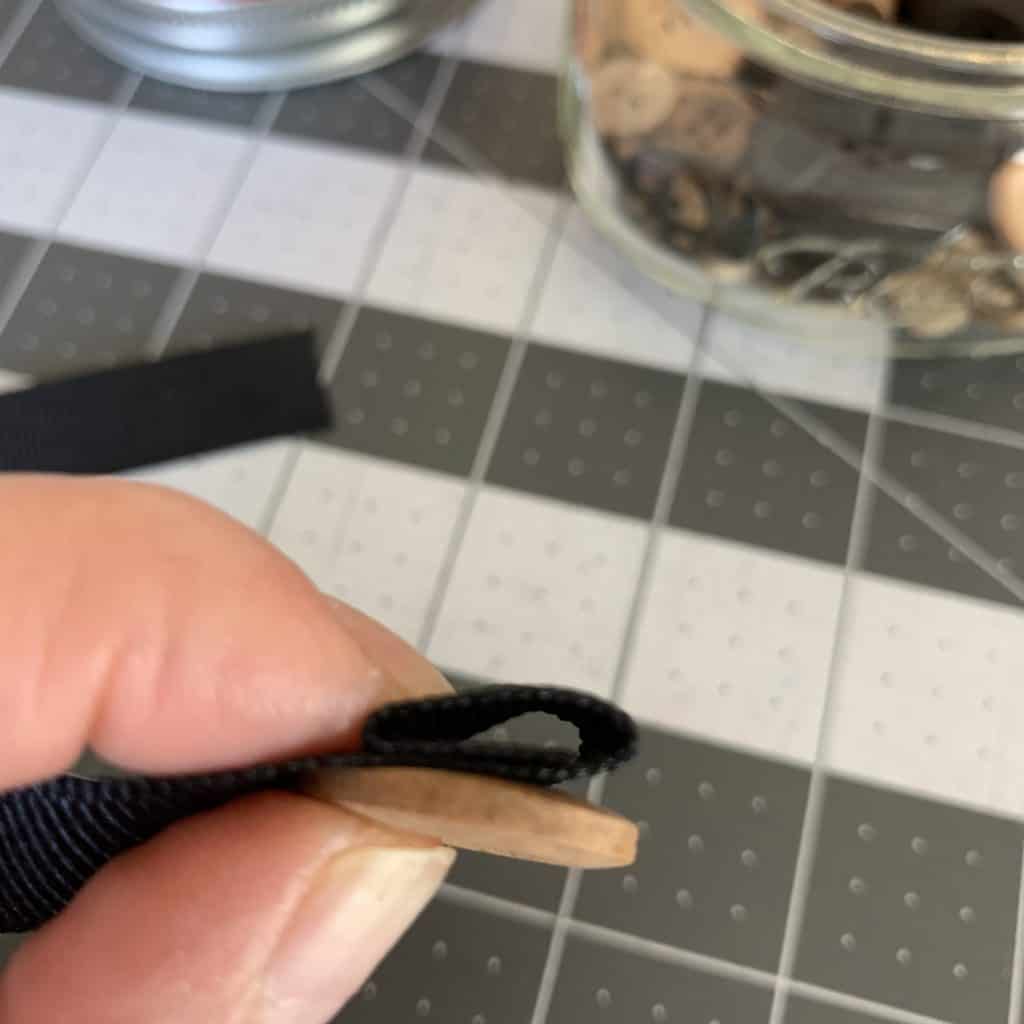
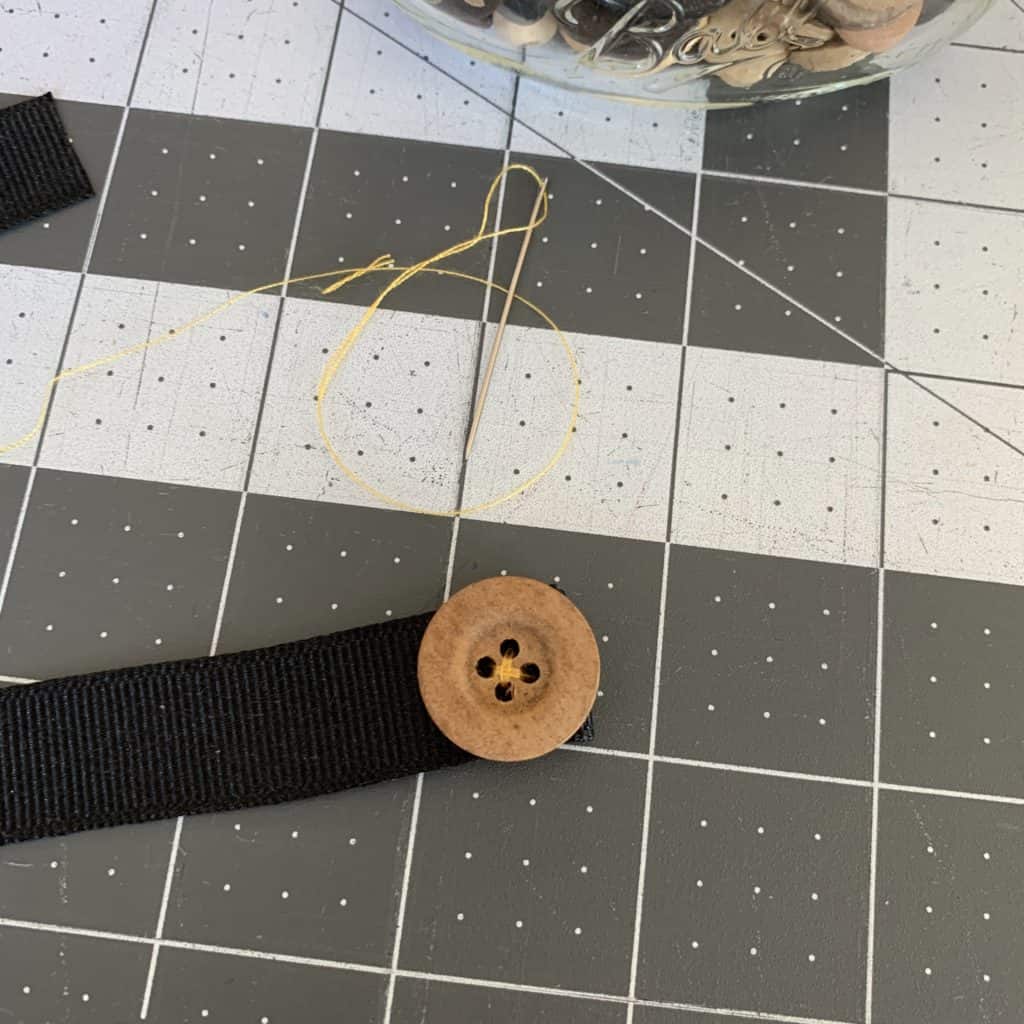
To wear, loop the elastic band (or ties) around one button, place around your head, then secure the second elastic band around the other button.
Version 2 -
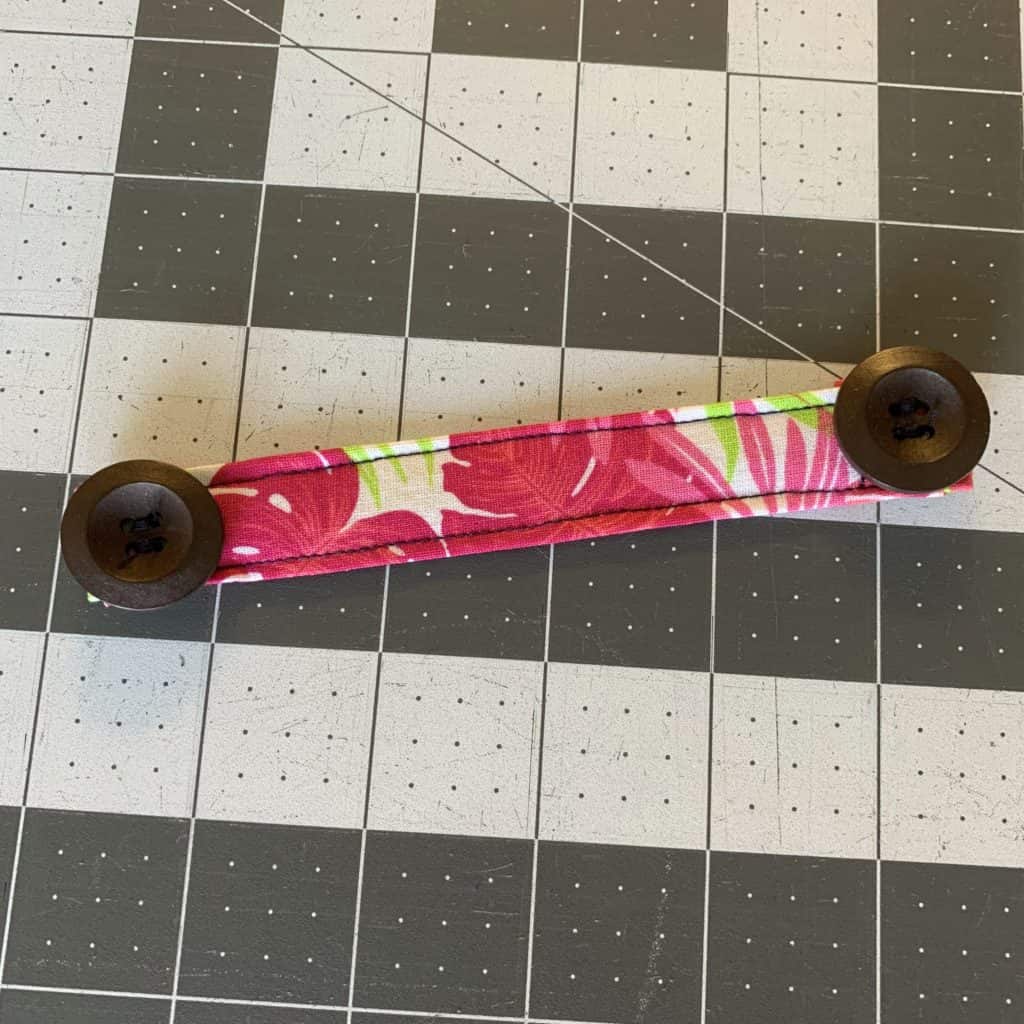
Cut you fabric your desired length (I chose 8 inches) buy roughly 2-3 inches (I chose 2 1/2 inches).
Again, if you can measure how much you need by putting on your mask and measure the gap between the elastic loops behind your head, you'll get a better measurement. But do what you can do!
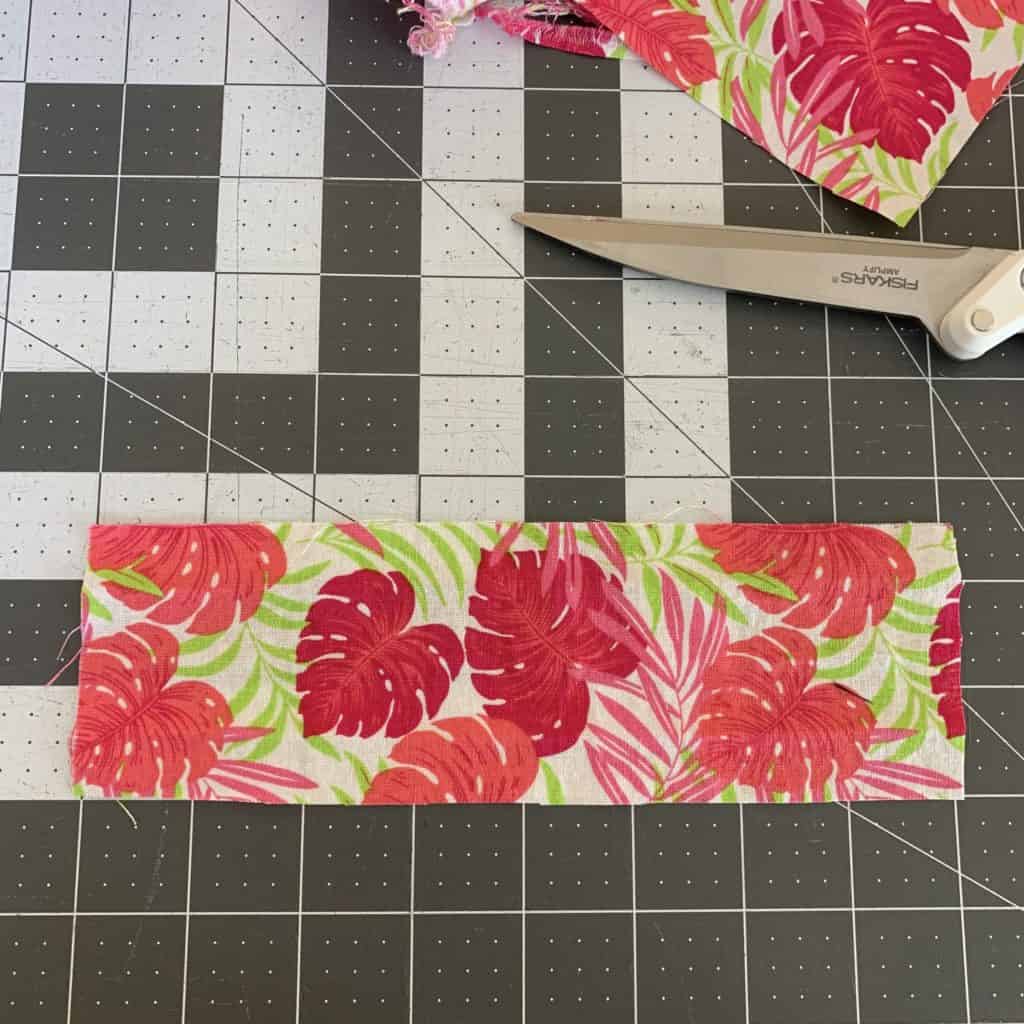
Turn the piece over, so the right (printed) side is facing down, then fold the top and bottom (long) edges to the center. Next, fold in half along the center line where the two raw edges meet. You'll have a long, thin strip.
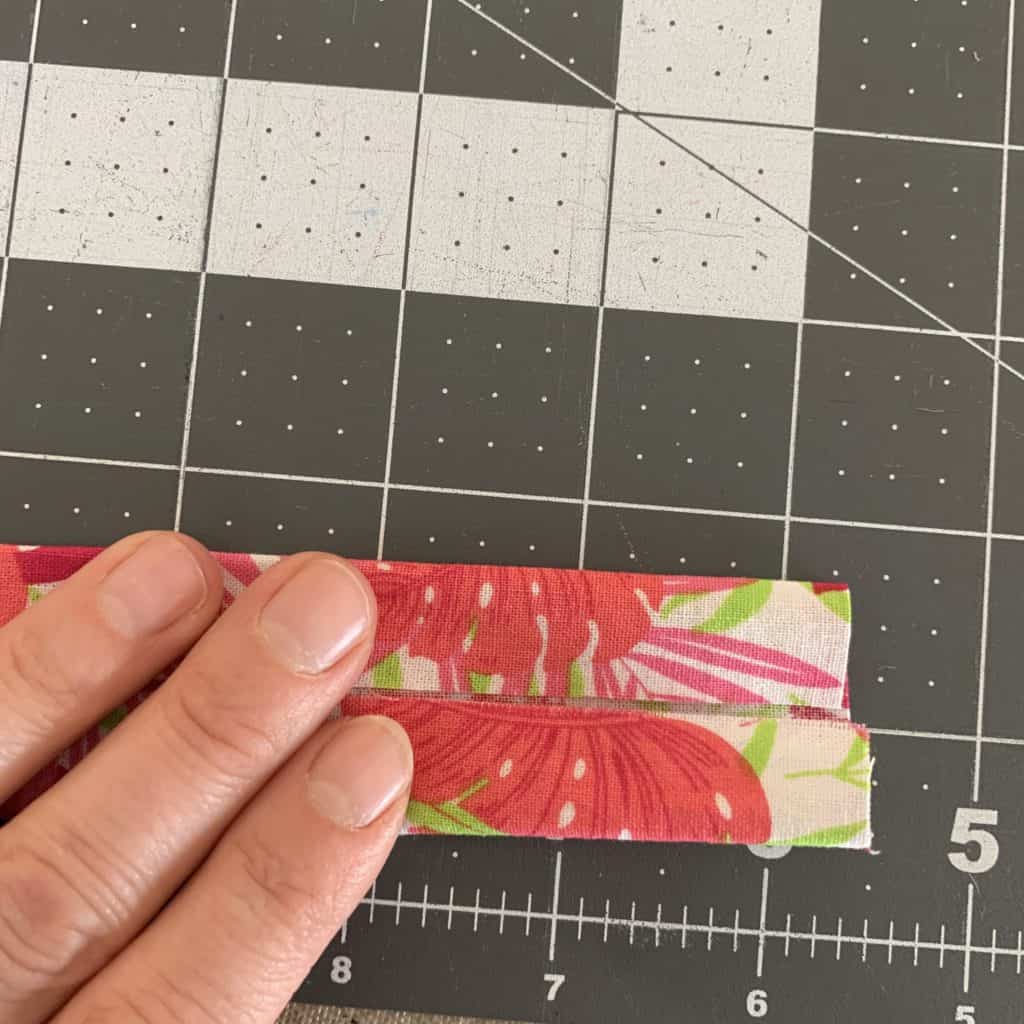
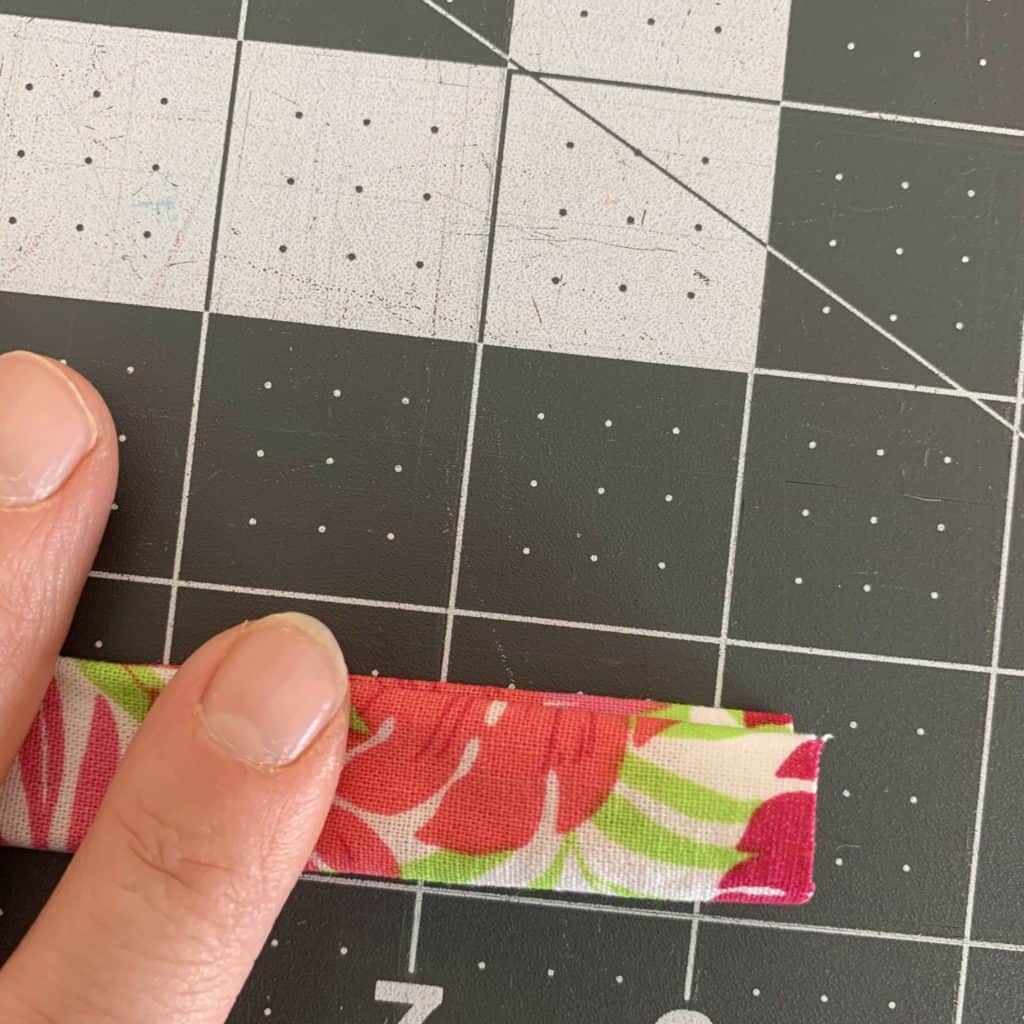
Just as with version 1, fold the ends under 1/2 inch two times to prevent fraying and add stability.
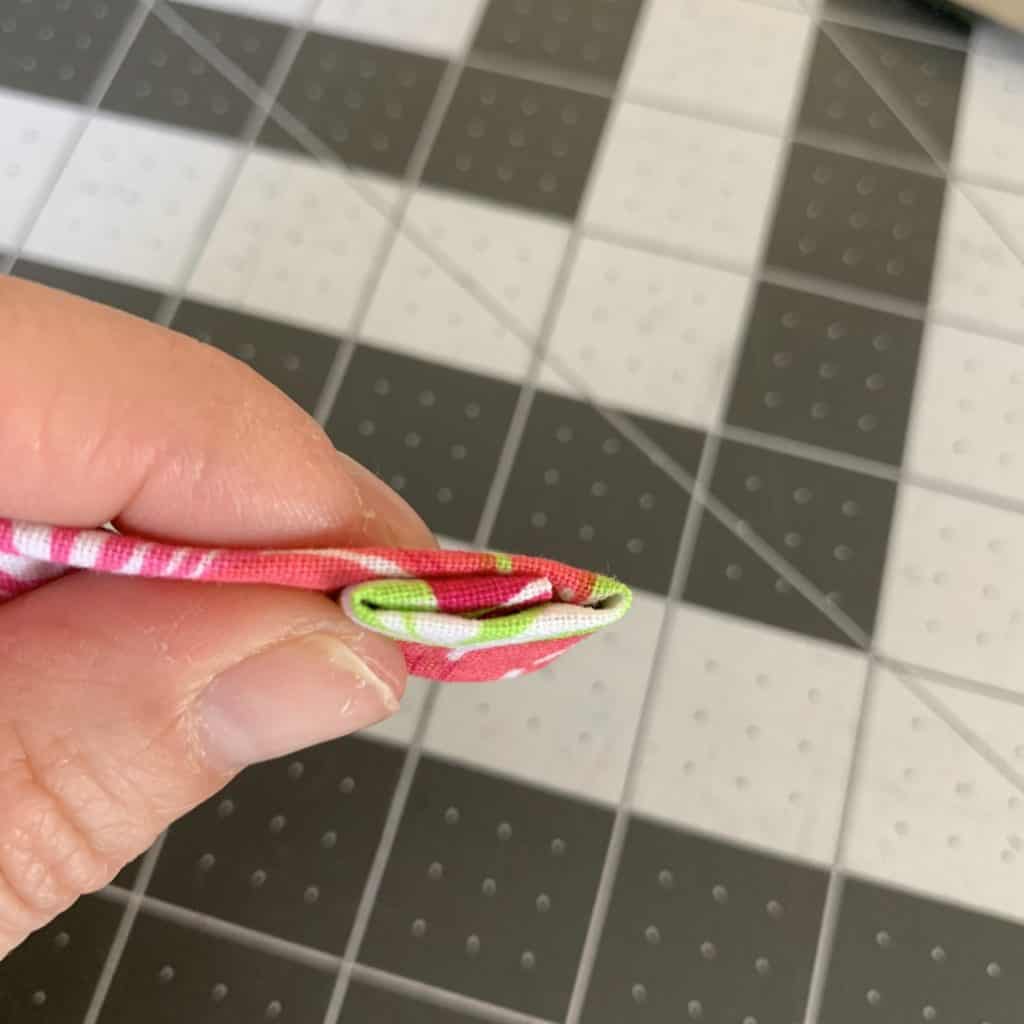
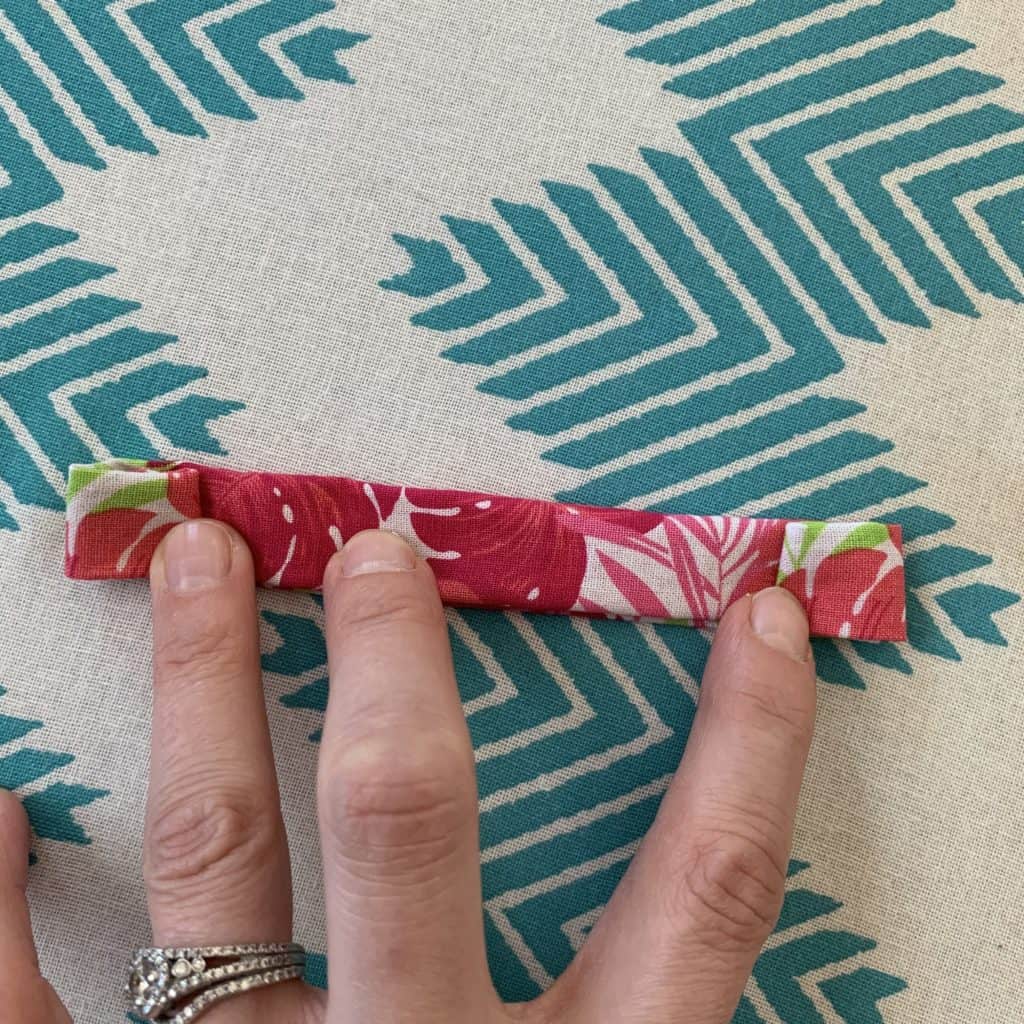
Press with an iron if desired but it's not necessary.
Optional: Topstitch around the four outside and folded edges to secure in place, as I've done.
Add a button to each side, sewing in place by hand or with a sewing machine.
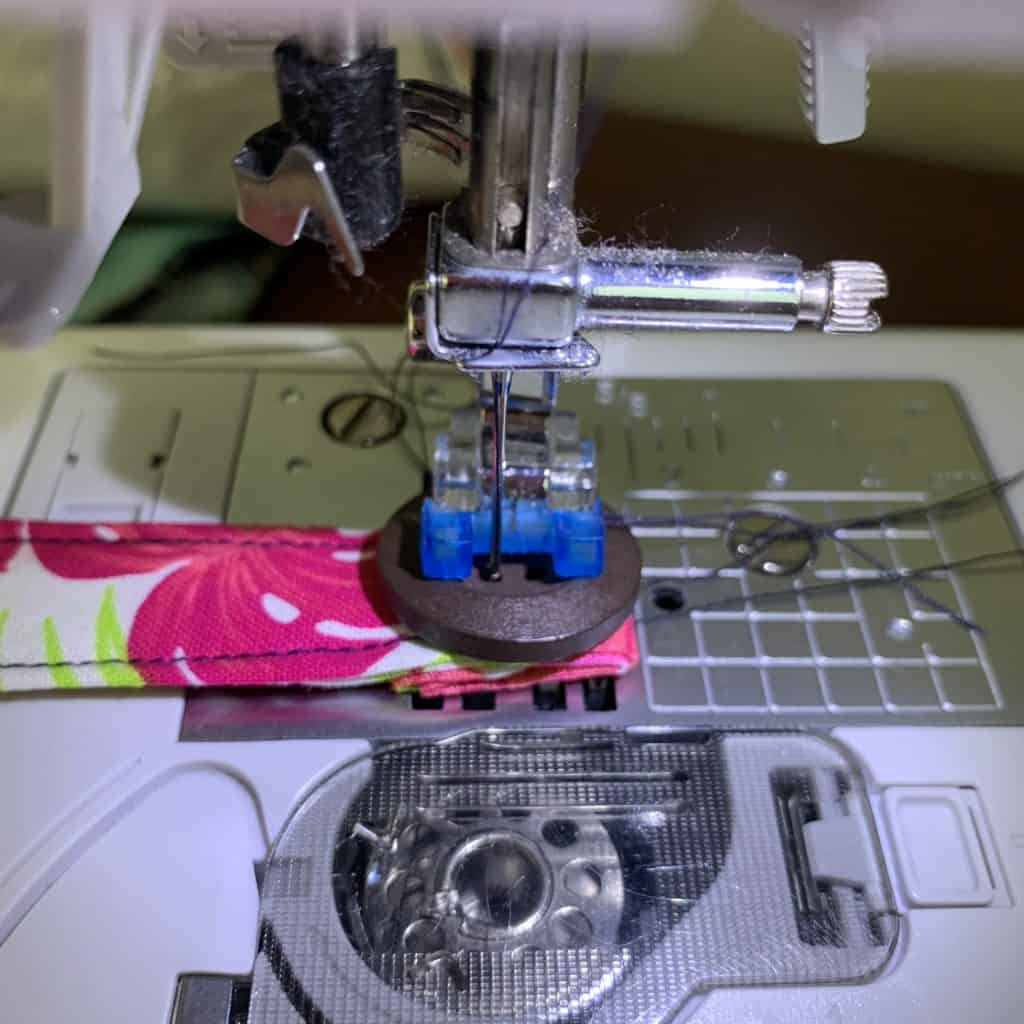
To wear, loop the elastic bands (or ties) around one button, place around your head, then secure the second elastic band around the other button.
Snap Tab Ear Guard
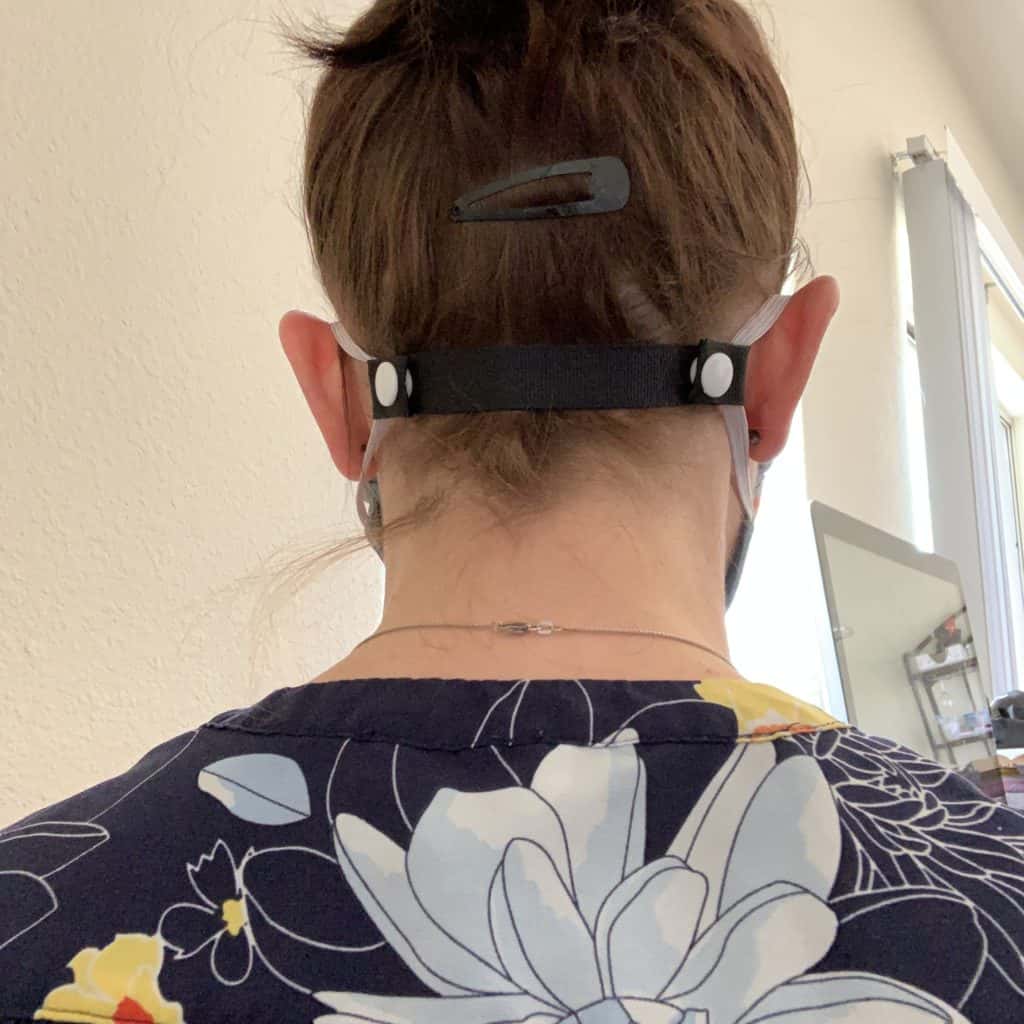
This is very similar to the button ear guard, but is made with plastic snaps instead of buttons. And, just like the button tab ear guard, can also be used with masks that have ties.
The construction of this snap tab is almost identical to the button tab, but you need an additional 2-3 inches of material since you will be folding the ends over to snap.
Materials Needed
- Fabric/Material
- Grosgrain ribbon, fabric scraps, leather, a crocheted strip, or anything you can find that you think would work
- You need a strip 6-8 inches long by about 1 inch wide.
- (Last time... but I've gotta say it!) Check out KnitFabric.com for every sort of fabric you need. They have it all!
- Two sets of plastic snaps (KAMSnaps, Dritz, etc.)
- Plastic snap hand tool/pliers or press
- Optional: awl to poke holes
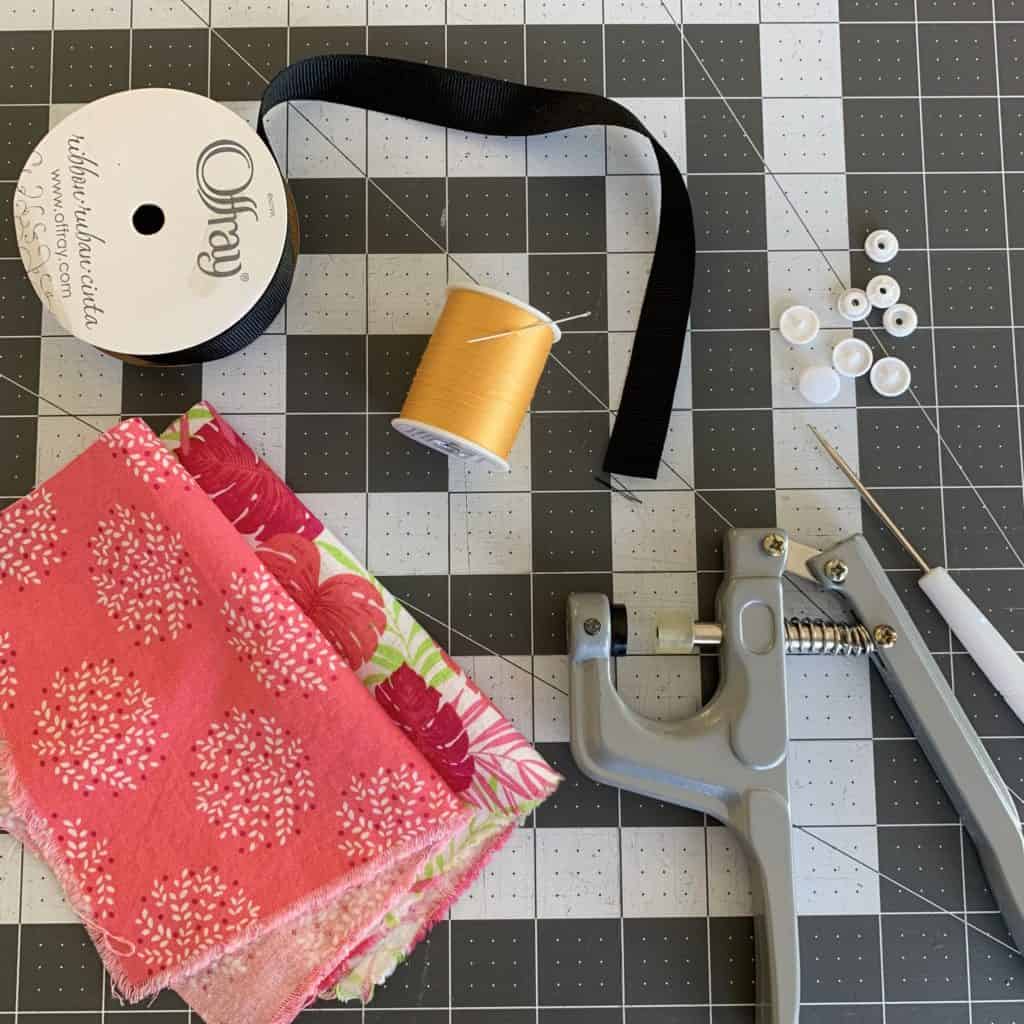
If you're using ribbon, fold the ends under 1/2 inch two times to prevent fraying and add stability.
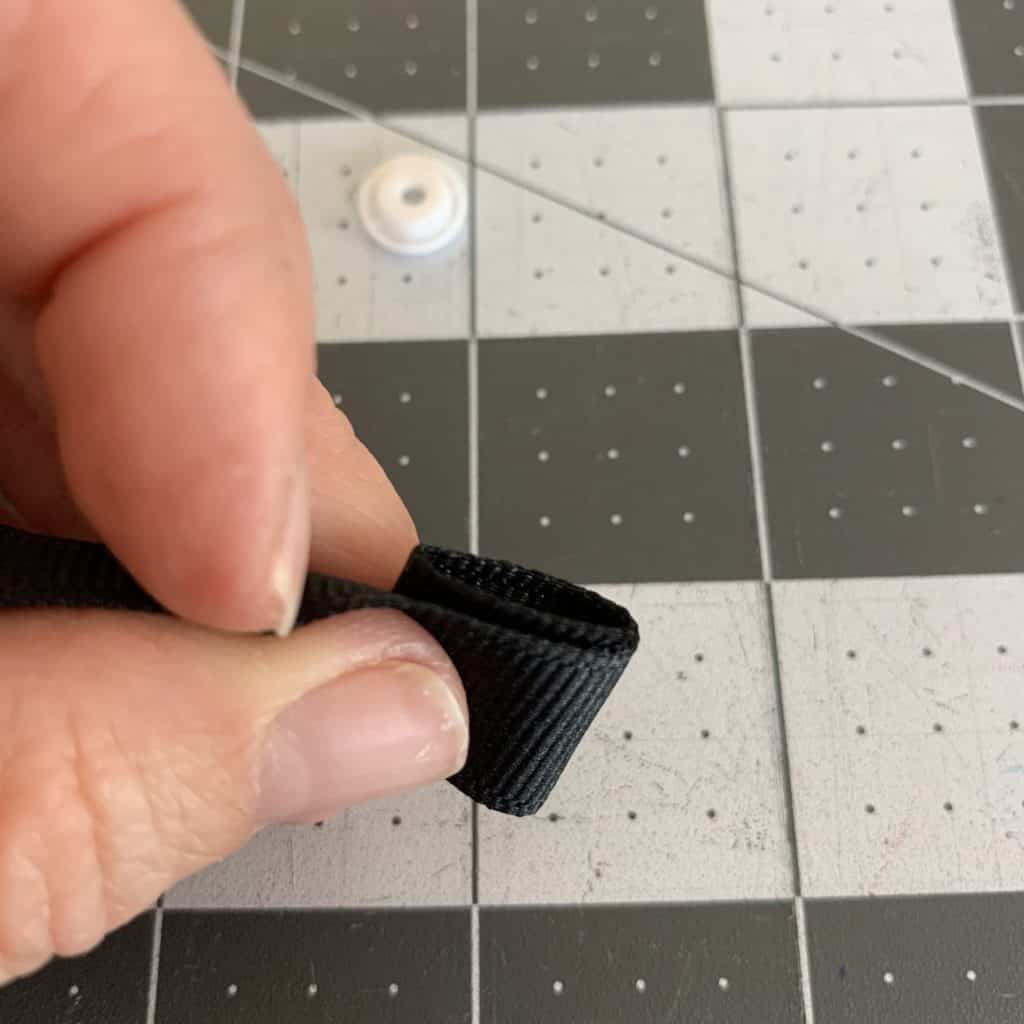
Add the first prong through the folded layers. The cap part of the prong will be seen from the outside, so press the prong through from the "top" (the folded parts being the "bottom") as shown in the image below.
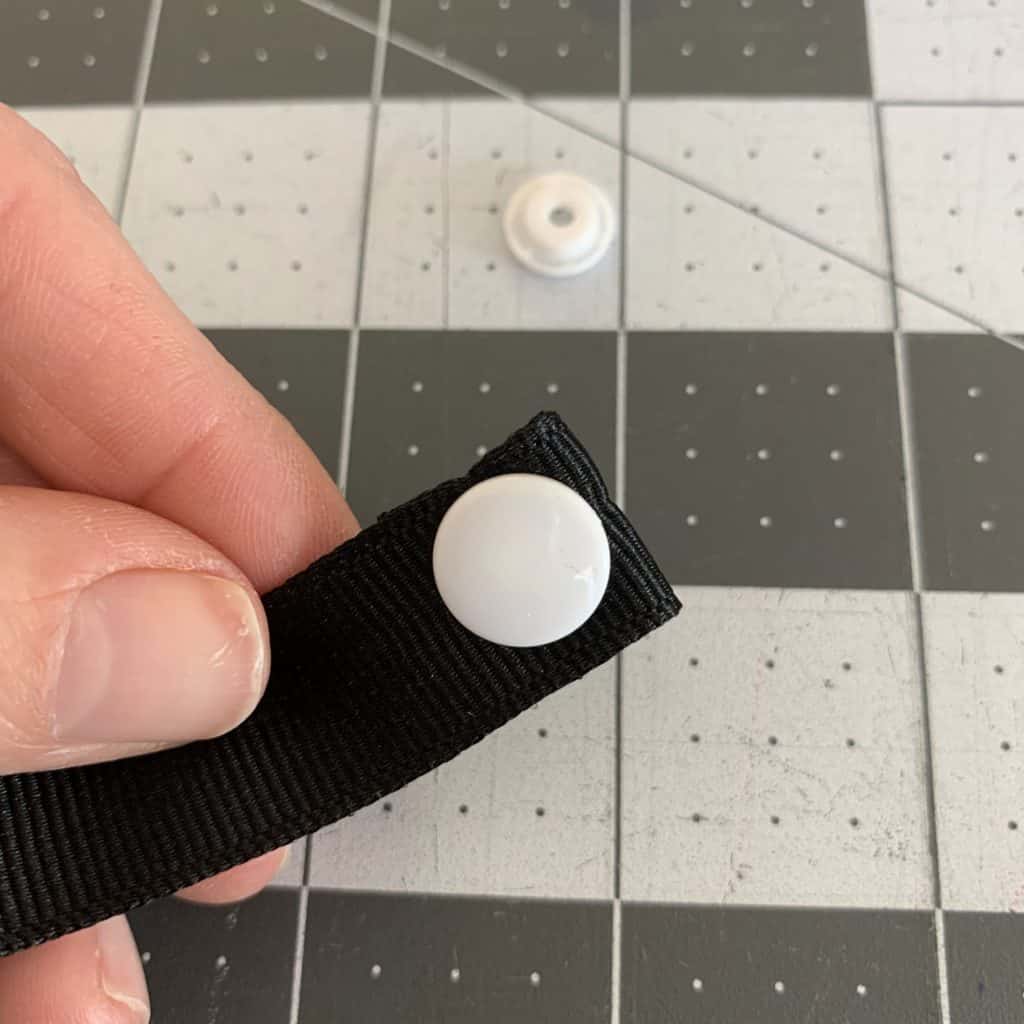
If using fabric scraps (like version 2 of the button tab above) fold in half, then in half again forming the long thin strip (I did not make this version for the snap tab).
Repeat with the other side.
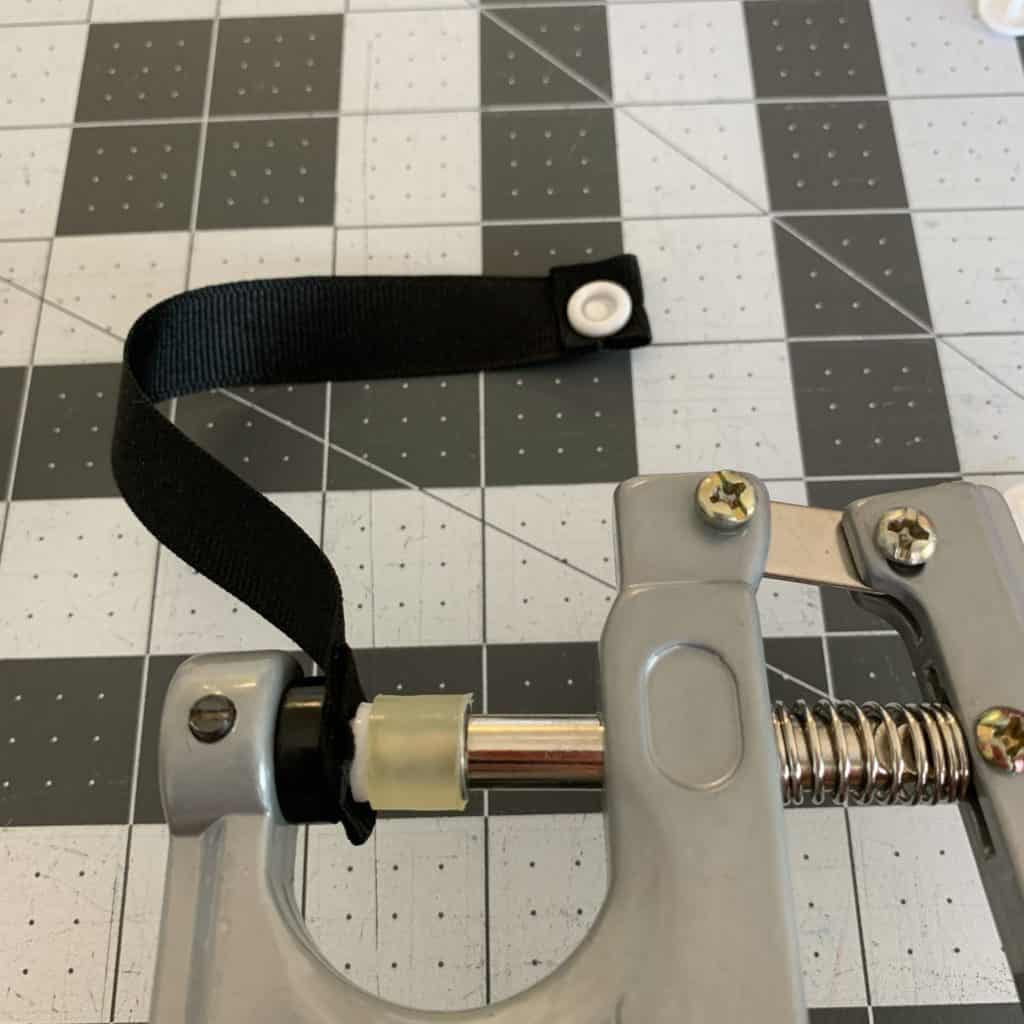
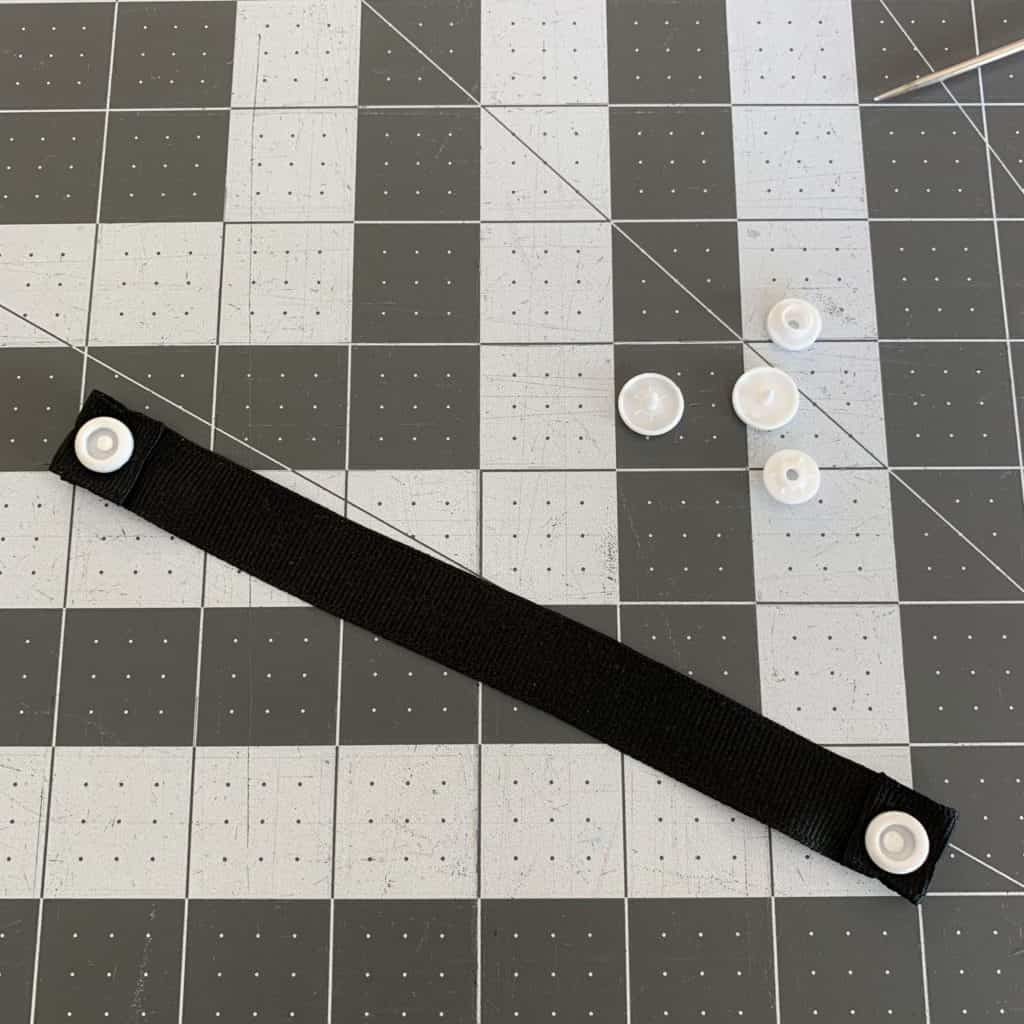
Measure 1-2 inches away from the edge of the tab and place the corresponding snap to complete the pair.
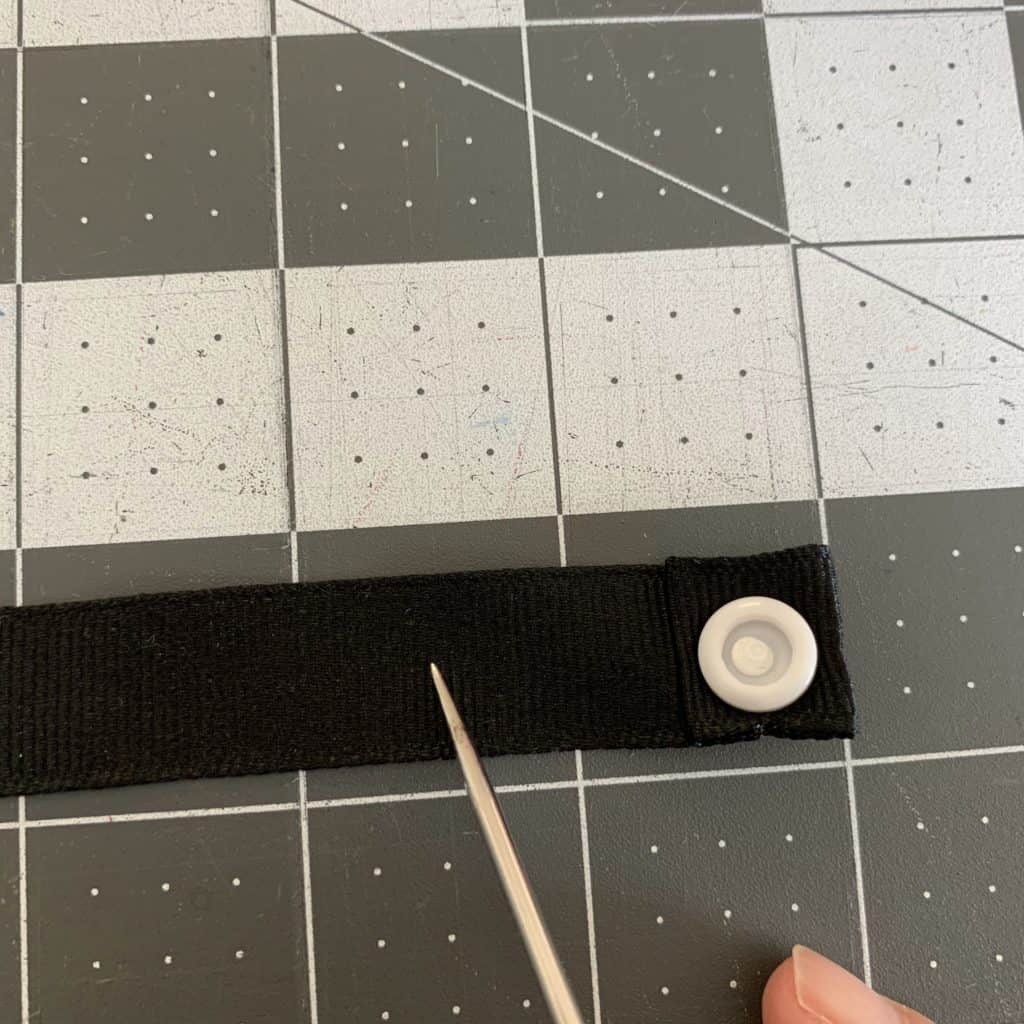
Repeat with the other side.
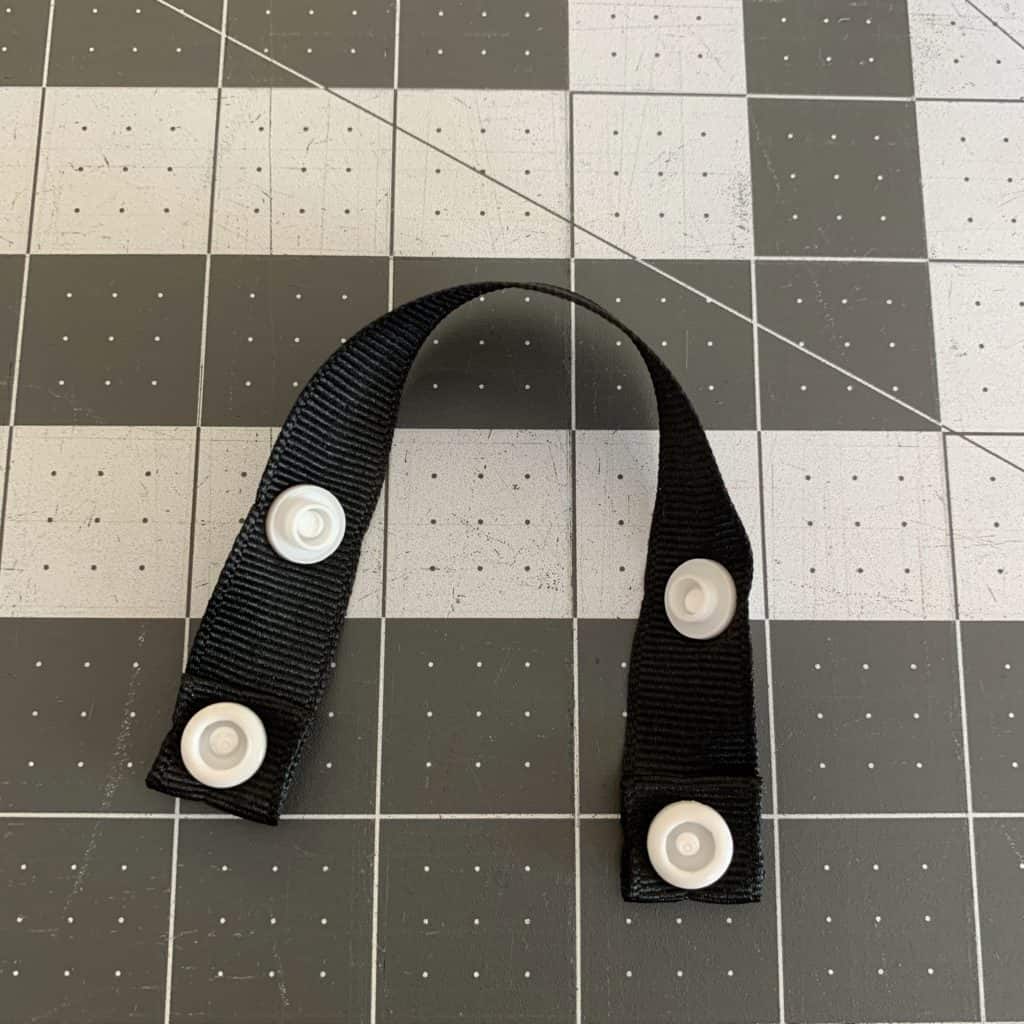
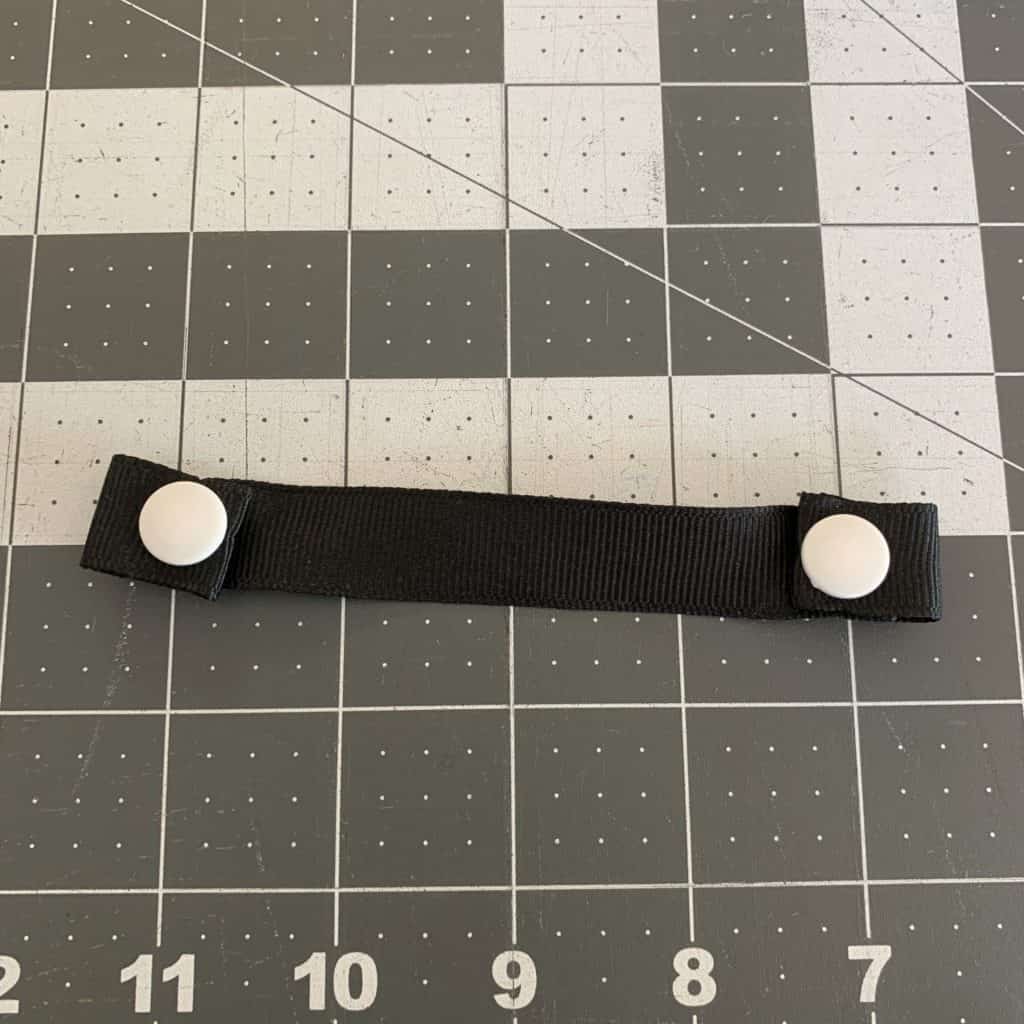
Done!
To wear, snap one end around the elastic loop (or tied ties), place around your head, then secure the second snap around the remaining elastic loop.
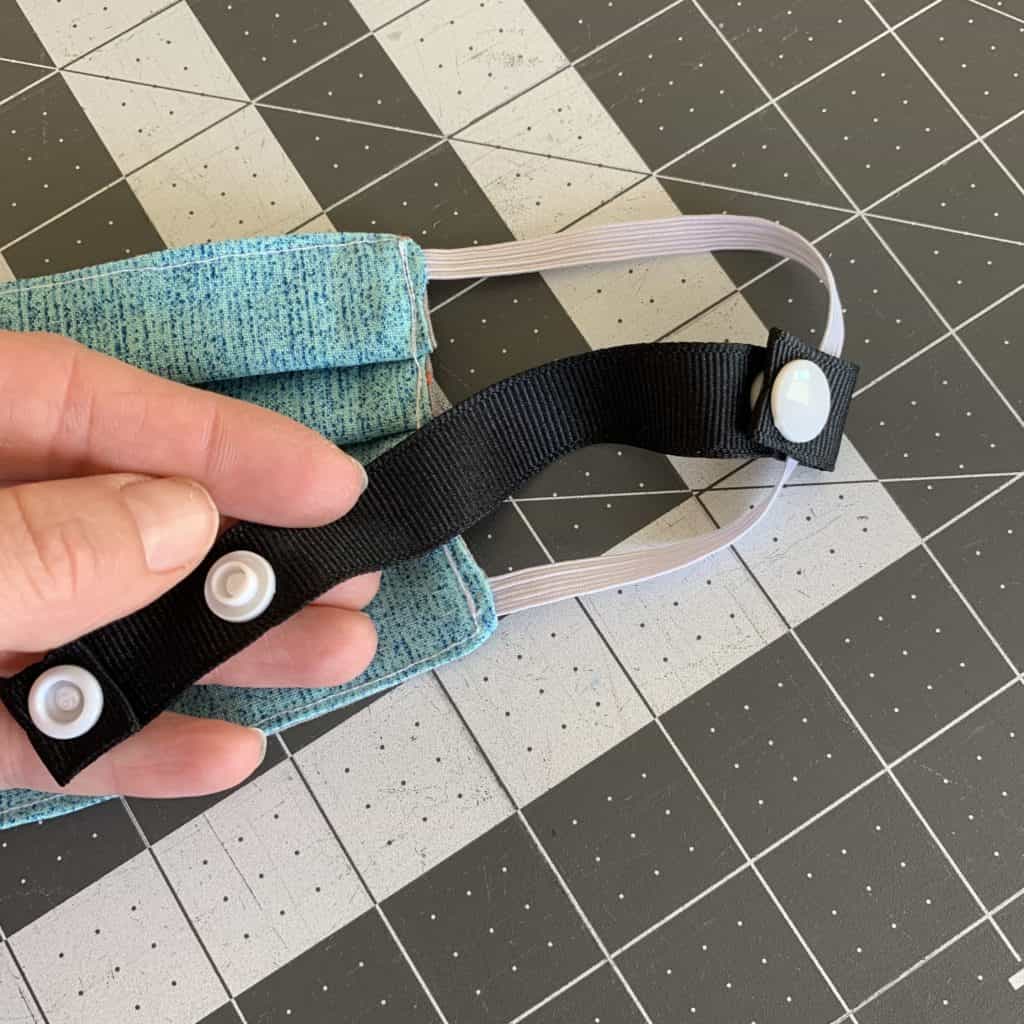
Other Options for Behind-the-Head Ear Guards
These don't need much explanation, so I'll move through them quickly. :)
Ribbon
Cut a 20-24" piece of ribbon, loop through the elastic bands (or tied ties) and tie.
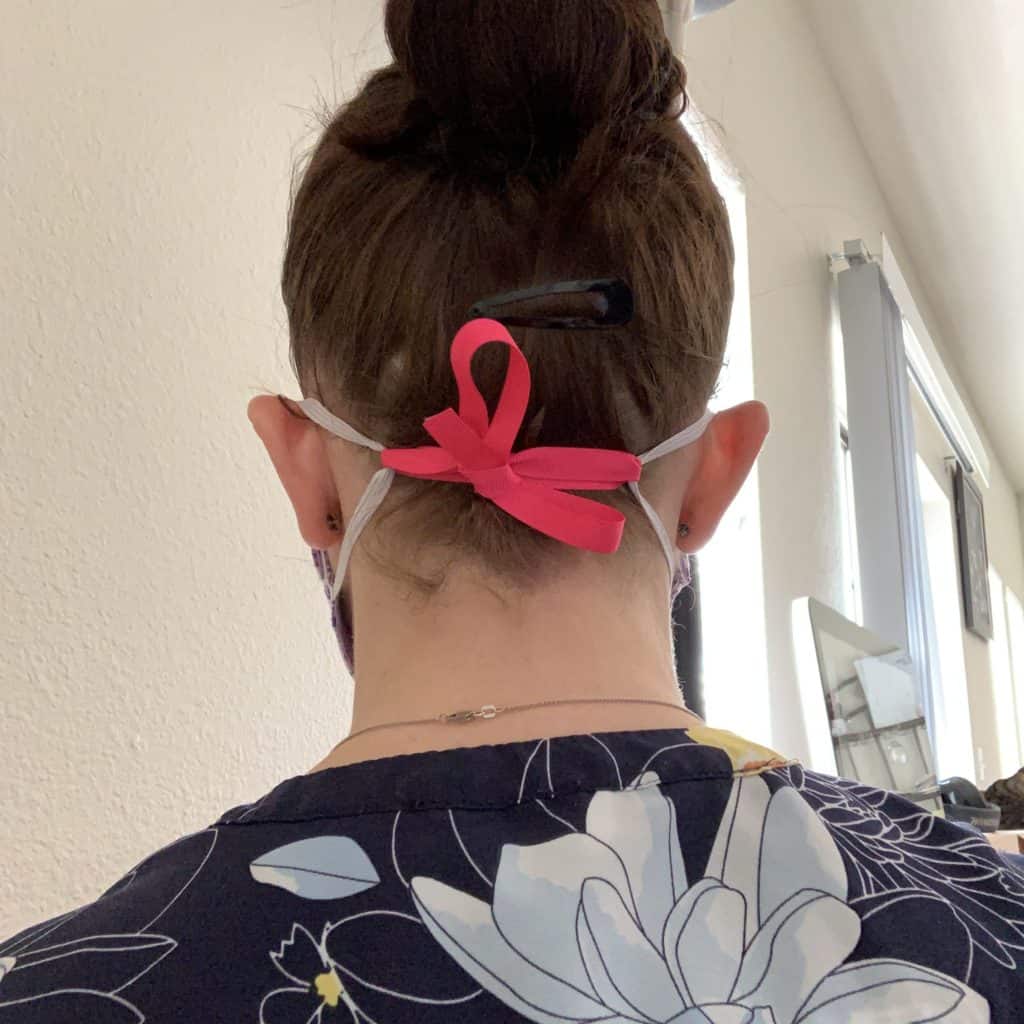
Paper Clip
This was a little tricky to get on - you have to put the paperclip on before putting on the mask.

Safety Pin
Use this one at your own discretion and never with children. It poked my finger and the back of my head as I was putting it on, but it works, and is an option if need be.
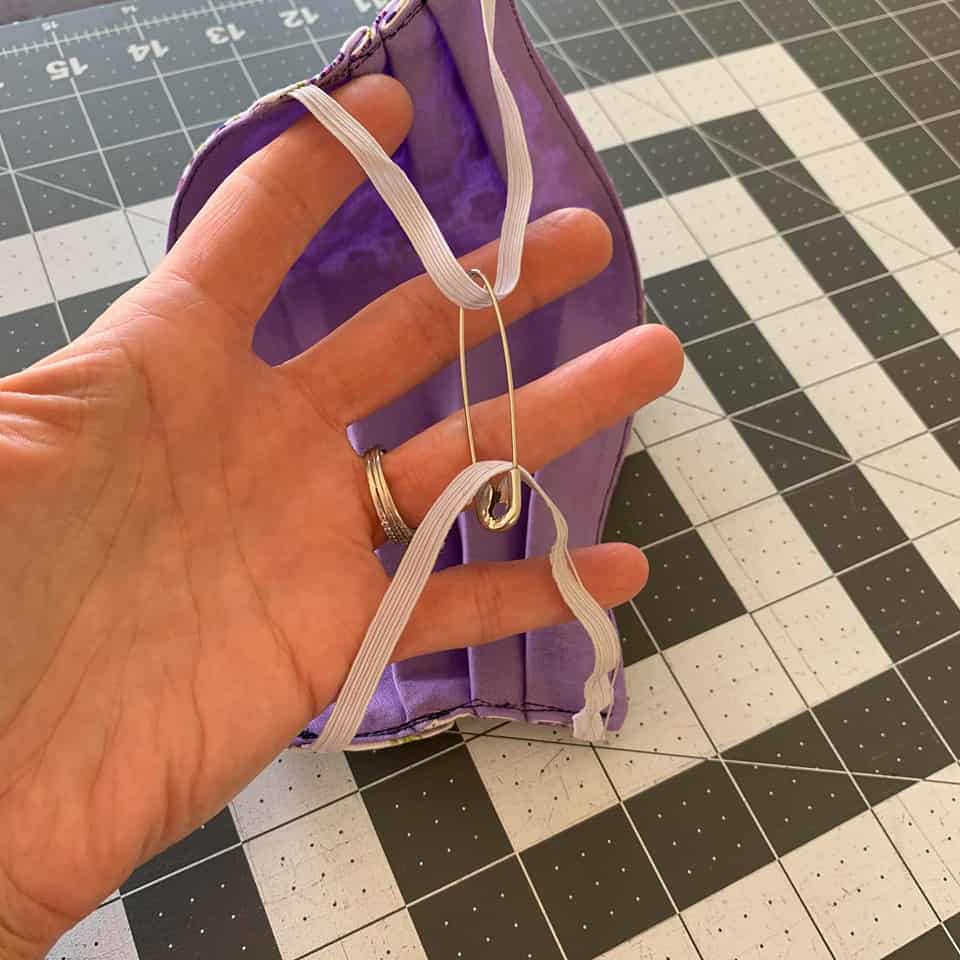
One more tidbit before I go.
Before I started using the tie headband, my face mask was too large. My solution? Pinch the elastic to the desired fit, then put a few stitches in the elastic behind the ears to shorten it. Problem solved! If you don't like any of the ideas above, maybe this is the simple solution for you. :)
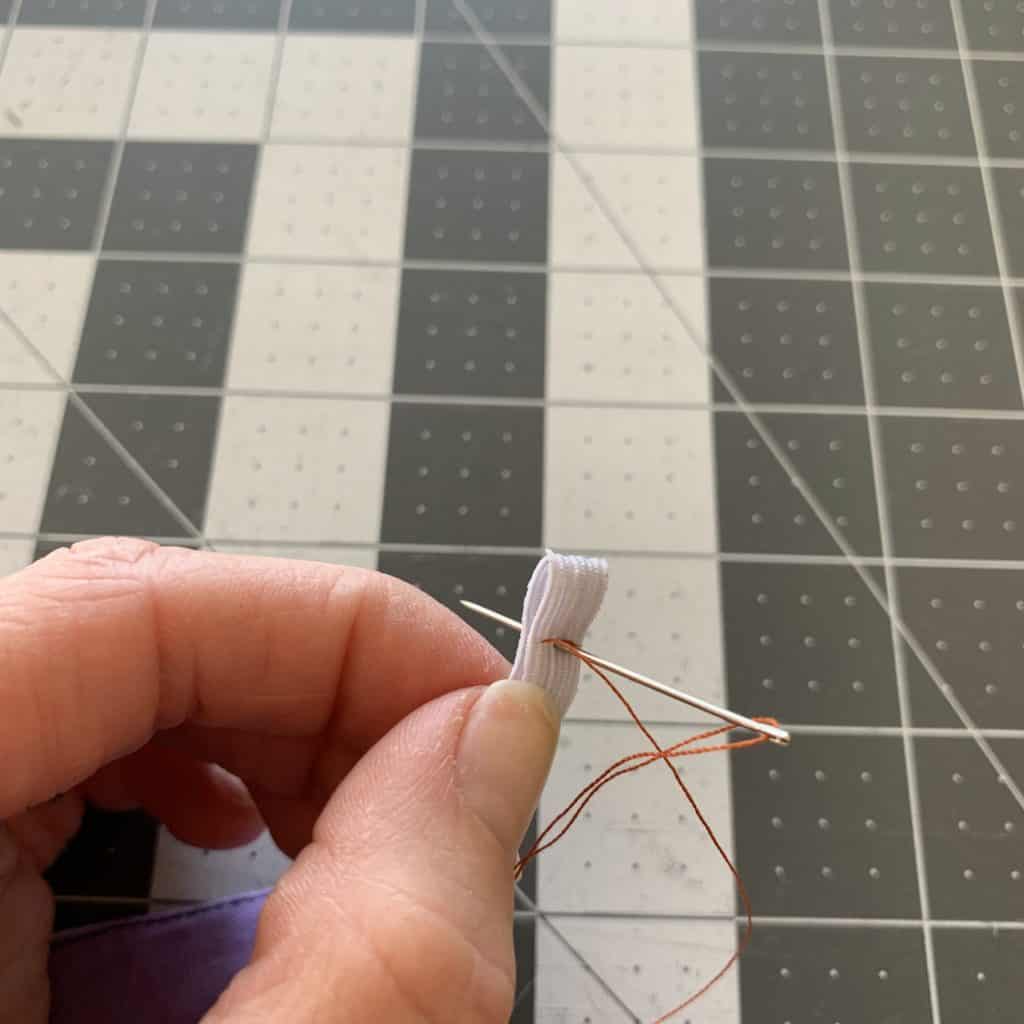
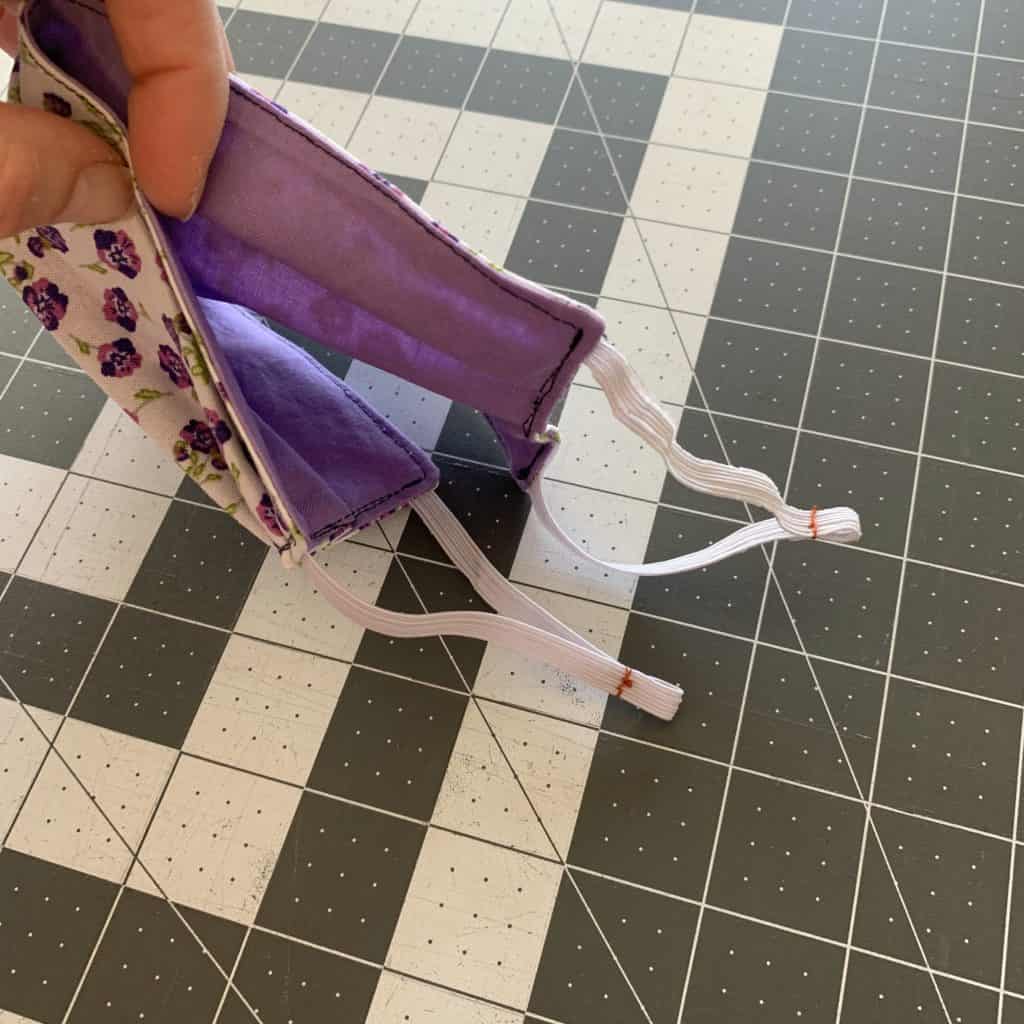
And that's it! That's all I have! I'm sure there are a million other ways to protect your ears from the elastic during ear, but for now, I think you have plenty to choose from.
Please stay safe, healthy, and happy. We'll make it through this one day at a time.


